 This is one that I didn't even know existed until I just stumbled across it in Wal-Mart one time when I was ten years old. It was the beginning of the summer of 1998 and I had either just seen the new TriStar Godzilla movie or I was about to (I think it was the former). Whatever the case, I was just milling around in the electronics department at a Wal-Mart one day when I came across the VHS of this movie. This was a Godzilla movie that I had never heard of, which is understandable since all of the Heisei entries after Godzilla vs. Biollante didn't get released in America until around this time in preparation for the release of the TriStar movie and also because I didn't yet have the Godzilla Compendium, which would later inform me of many other flicks that I didn't know about at the time. Upon seeing it, I first thought that this movie might be Ghidorah, the Three-Headed Monster, which I hadn't seen yet at that point, but upon reading the back, I discovered that wasn't the case due to the plot and because it said that Godzilla was going to fight a "solo battle," whereas I knew that in Ghidorah, he teamed up with Mothra and Rodan. In any case, for some reason, I didn't buy it the first time I saw it. I'm not sure why. I do, however, remember that my step-cousin was with me that time (I'm now pretty sure that this happened the very weekend we saw the TriStar movie) and we both saw it together, whereas it was just my dad and I when actually did purchase it. When I watched it the next day, it was quite an experience because as it played out, I gradually realized that I already knew elements of the plot of this movie thanks to the descriptions on the back of that Godzilla action figure box I mentioned in the previous review. Not only did this film corroborate the story that was told about Godzilla's origin on the back of that box (at the time, I didn't quite grasp the idea of him being an atomic mutant) but it also matched up with its description of King Ghidorah's origin, that three creatures known as Dorats were combined into one enormous monster. That origin never made sense to me because in the movies I had seen, Ghidorah was always just a space monster but now, I understood what that package was talking about and, like Biollante, I continued to realize that all of the stuff on the back of that box wasn't made up to sell toys, as I used to think. As for the movie itself, I rather enjoyed it. I thought it was quite cool, with the time-travel concept, the explanation of Godzilla's origin, and how they ended up making Godzilla larger and more powerful by trying to eliminate him from history. My step-cousin seemed to really like it as well when I showed it to him shortly afterward. For a long time, it was one of my favorite entries in the Heisei series and I know I'm not alone, since this often cited as being one of the best in the entire franchise by many fans.
This is one that I didn't even know existed until I just stumbled across it in Wal-Mart one time when I was ten years old. It was the beginning of the summer of 1998 and I had either just seen the new TriStar Godzilla movie or I was about to (I think it was the former). Whatever the case, I was just milling around in the electronics department at a Wal-Mart one day when I came across the VHS of this movie. This was a Godzilla movie that I had never heard of, which is understandable since all of the Heisei entries after Godzilla vs. Biollante didn't get released in America until around this time in preparation for the release of the TriStar movie and also because I didn't yet have the Godzilla Compendium, which would later inform me of many other flicks that I didn't know about at the time. Upon seeing it, I first thought that this movie might be Ghidorah, the Three-Headed Monster, which I hadn't seen yet at that point, but upon reading the back, I discovered that wasn't the case due to the plot and because it said that Godzilla was going to fight a "solo battle," whereas I knew that in Ghidorah, he teamed up with Mothra and Rodan. In any case, for some reason, I didn't buy it the first time I saw it. I'm not sure why. I do, however, remember that my step-cousin was with me that time (I'm now pretty sure that this happened the very weekend we saw the TriStar movie) and we both saw it together, whereas it was just my dad and I when actually did purchase it. When I watched it the next day, it was quite an experience because as it played out, I gradually realized that I already knew elements of the plot of this movie thanks to the descriptions on the back of that Godzilla action figure box I mentioned in the previous review. Not only did this film corroborate the story that was told about Godzilla's origin on the back of that box (at the time, I didn't quite grasp the idea of him being an atomic mutant) but it also matched up with its description of King Ghidorah's origin, that three creatures known as Dorats were combined into one enormous monster. That origin never made sense to me because in the movies I had seen, Ghidorah was always just a space monster but now, I understood what that package was talking about and, like Biollante, I continued to realize that all of the stuff on the back of that box wasn't made up to sell toys, as I used to think. As for the movie itself, I rather enjoyed it. I thought it was quite cool, with the time-travel concept, the explanation of Godzilla's origin, and how they ended up making Godzilla larger and more powerful by trying to eliminate him from history. My step-cousin seemed to really like it as well when I showed it to him shortly afterward. For a long time, it was one of my favorite entries in the Heisei series and I know I'm not alone, since this often cited as being one of the best in the entire franchise by many fans. It wasn't until I got older and began to read critical reviews of the film that my viewpoint on it began to change. While I still did, and do, like the film, it became apparent that it was hardly flawless. In fact, you can punch so many holes in this movie's plot, especially in the time-travel element, that it's unbelievable. It serves as proof that, despite his enthusiasm and desire to update Godzilla for a new generation, writer-director Kazuki Omori didn't think things through enough while putting together the stories that he wanted to tell, and that he also now seemed compelled to out and out steal from popular Hollywood blockbusters rather than just heavily emulate them, as he had done with Godzilla vs. Biollante. Speaking of which, though, I do find this film to be more entertaining than that one. It has a stronger sense of fun and isn't 100% concerned with trying to make the series more adult and complex, although the issues it brings up are interesting ones not unworthy of discussion, and it still has the high standard of special effects that Koichi Kawakita had established with Biollante (well, for the most part, anyway). I'd call it a diamond in the rough: it has more than its fair share of flaws, and, in fact, I now think it's a bit of an overrated entry, but, at the end of the day, it does deliver the goods in terms of crazy sci-fi escapism and entertainment.
The year is 1992 and lately, there have been sightings of a UFO around Tokyo. Terasawa, a writer who has written about psychic phenomena and has a connection to a magazine that specializes in strange issues of science, is asked to write an article for them on the subject but he's more interested in a man who claims to have seen a dinosaur while serving in World War II. Terasawa meets with the man, who tells him of how a garrison of Japanese troops made a last stand against the Americans on the small island of Lagos in 1944 and that they were saved when a dinosaur suddenly appeared and drove the Americans back. Terasawa later discovers that in 1954, an H-Bomb test occurred in the nearby Bikini Atoll and he develops a theory that the dinosaur transformed into Godzilla after being exposed to the radiation. He also learns that Yasuaki Shindo, a wealthy businessman who was one of the key architects of Japan's postwar prosperity, was the commander of the Lagos garrison, meaning that he must have seen the dinosaur as well. When Terasawa first meets with Shindo, the businessman laughs off their claims of a living dinosaur but his mood changes when he's told of the theory and he confirms the dinosaur's existence by showing old photographs of the creature to Terasawa and his friends, Prof. Mazaki and psychic Miki Saegusa, the latter of whom is now part of the Godzilla Countermeasures Unit of the Japanese military. Meanwhile, the military investigates the UFO, which was last seen around Mt. Fuji, and they discover that not only is it real but that it's actually a time-machine piloted by people from the year 2204. The three commanders of the UFO, two American men named Wilson and Grenchiko and a Japanese woman named Emmy Kano, meet with the government officials, including the prime minister, and tell them that in the era where they come from, Japan no longer exists. They explain that in the 21st century, Godzilla, who is currently still reeling from the effects of the Anti-Nuclear Energy Bacteria and his battle with Biollante, will return to Japan and cause widespread nuclear pollution by destroying atomic plants across the country, making it uninhabitable. The visitors say that they plan to save Japan by going back in time to before the dinosaur became Godzilla and remove him from the site, preventing his future mutation. Emmy and their advanced android, M-11, along with Terasawa, Mazaki, Miki, and three little winged creatures called Dorats, travel back in time to 1944 and witness the battle between the American and Japanese troops on Lagos Island, as well as the subsequent appearance by the dinosaur. Once the dinosaur is critically wounded by an attack from an American battleship, he's transported away from the island and placed in the Bering Sea. However, before they leave to return to 1992, Emmy secretly leaves the three Dorats behind on the island. Upon returning, they learn that Godzilla is indeed gone... but a powerful and violent three-headed dragon called King Ghidorah has taken his place. The creature wreaks havoc across Japan while being controlled by the visitors, who plan to use it in a plan to blackmail the country into subjugation because it's revealed that in their time, Japan has actually become an extremely powerful nation. The government officials, realizing that their weapons can't defeat King Ghidorah, contemplate changing the dinosaur in the Bering Sea into Godzilla and ask Shindo, whose corporation secretly owns a nuclear submarine, to help in doing so. However, it's discovered too late that Godzilla has already been reborn thanks to a sunken nuclear submarine in that same area, and he grows even more powerful upon destroying the sub Shindo sent out. Godzilla soon returns to Japan but the question now is, even if he manages to defeat King Ghidorah, who will save Japan from him?
Although Godzilla vs. Biollante hadn't been the most popular entry in the series, it did well enough to encourage Toho to give the go ahead for another movie, which was originally slated for release in December of 1990. However, it got delayed for another year for several reasons, one of them being that Tomoyuki Tanaka, who was 80 by this point, underwent brain surgery in 1990 and the aftereffects of it, in addition to his age, really limited his involvement with the film's development. Therefore, he handed the producing duties over to Shogo Tomiyama, whose first involvement with the series had been in producing Biollante along with Tanaka, while Tanaka himself took a more hands-off role as executive producer, which is how it would be for the rest of the films made during his lifetime. When Tomiyama took over as producer, he decided that the next film needed to bring back some of the fantastical elements of the Showa series, feeling that one of the reasons for Biollante's underperformance at the box-office, other than its having barely any promotion, was that it was far too adult-oriented, with a complex story that didn't appeal to kids. Tomiyama didn't want the series to go back to the absolutely juvenile tone and feel it had reached in the 1970's but rather to strike a balance where you had fun, monster action and escapist fantasy along with the deep, topical aspects of the stories. Furthermore, since people weren't all that taken with Biollante herself, Tomiyama and the heads at Toho, as well as Tanaka himself, decided that they needed to bring back some of Godzilla's classic monster opponents. In fact, they originally wanted to do a rematch between Godzilla and King Kong, no doubt to see if they could have another enormous hit akin to the 1962 film (it was also motivated by how 1992 was going to be Toho's 60th anniversary and King Kong vs. Godzilla had been the big celebratory film for its 30th), but Turner Entertainment, the rights-holders to the character of Kong, wanted too much money. They also toyed with the idea of pitting Godzilla against Mechani-Kong, the giant ape's robot doppelganger who had appeared in 1967's King Kong Escapes, but they felt that even that might be close enough to the character of Kong himself that they would get sued, so that was dropped. That's when the decision was made to resurrect Godzilla's most popular foe, King Ghidorah, who hadn't been in a film since Godzilla vs. Gigan in 1972. When this matter was finally settled, Kazuki Omori, who had been asked back as writer-director, had to completely abandon the other story ideas he was working on for the film and write a completely new one, delaying the film's production even further. But, delays and the final film's uneven quality aside, it ended up paying off when Godzilla vs. King Ghidorah became a big hit when it was released in December of 1991. After that, the Heisei series would begin in earnest, with a new film being released every year, just like the good old days, until its conclusion in 1995.
 After Godzilla vs. Biollante, the only thing that Kazuki Omori had done was writing and directing an episode of a 1990 anthology film called The Reason Why I Became Ill (I have no idea), although he had also been trying to resurrect Mothra in a script called Mothra vs. Bagan. While that particular film would never come to be, he would ultimately succeed in bringing Mothra back in 1992 when he wrote the screenplay for the next Godzilla film, Godzilla and Mothra: The Battle for Earth. As his mindset when developing the story for Godzilla vs. King Ghidorah, Omori had concluded that Godzilla vs. Biollante didn't do well because of stiff competition from Back to the Future Part II and, from that, reached a personal epiphany: audiences wanted time-travel movies. Now, that idea right there should be an indication of the strange ideas and conclusions that Omori could come to (no offense to the guy but doesn't that sound like something that a little kid who can't see the big picture would think up?) As I said back in my review of Biollante, a lot of people have mixed feelings about his approach to the franchise and I'm the same way because, while I appreciate his taking the whole thing seriously and wanting to update Godzilla for a new generation, the way he went about it, by copying the elements of popular Hollywood spectacles of the time, was rather uncreative and, to be blunt, hackneyed. In fact, as his association with Godzilla went on, his approach only got worse. At the very least in Biollante, he emulated big Hollywood action movies, particularly the James Bond movies, in a very generic fashion with shootouts, espionage elements, and a sequence involving a ticking clock; here, he begins doing things that are borderline plagiarism, with the time travel plot, which is akin not only to Back to the Future but The Terminator as well since it's about an attempt to alter history, and, for that matter, the people from the future having an android who's more or less a stand-in for the Terminator (the fact that this came out the same year as Terminator 2 raises even more eyebrows). Now, on the flip-side, save for Biollante, all of the Godzilla movies that Omori was involved with proved to be extremely profitable, so I guess he was doing something right, but I still wish that he would have been a little more creative in his desire to update the franchise for the 90's. While Omori wouldn't direct another Godzilla, he would, as I said, write the screenplay for the next film and he also penned the script for the final Heisei film, Godzilla vs. Destoroyah, so I'll wait until then to talk about his career afterward.
After Godzilla vs. Biollante, the only thing that Kazuki Omori had done was writing and directing an episode of a 1990 anthology film called The Reason Why I Became Ill (I have no idea), although he had also been trying to resurrect Mothra in a script called Mothra vs. Bagan. While that particular film would never come to be, he would ultimately succeed in bringing Mothra back in 1992 when he wrote the screenplay for the next Godzilla film, Godzilla and Mothra: The Battle for Earth. As his mindset when developing the story for Godzilla vs. King Ghidorah, Omori had concluded that Godzilla vs. Biollante didn't do well because of stiff competition from Back to the Future Part II and, from that, reached a personal epiphany: audiences wanted time-travel movies. Now, that idea right there should be an indication of the strange ideas and conclusions that Omori could come to (no offense to the guy but doesn't that sound like something that a little kid who can't see the big picture would think up?) As I said back in my review of Biollante, a lot of people have mixed feelings about his approach to the franchise and I'm the same way because, while I appreciate his taking the whole thing seriously and wanting to update Godzilla for a new generation, the way he went about it, by copying the elements of popular Hollywood spectacles of the time, was rather uncreative and, to be blunt, hackneyed. In fact, as his association with Godzilla went on, his approach only got worse. At the very least in Biollante, he emulated big Hollywood action movies, particularly the James Bond movies, in a very generic fashion with shootouts, espionage elements, and a sequence involving a ticking clock; here, he begins doing things that are borderline plagiarism, with the time travel plot, which is akin not only to Back to the Future but The Terminator as well since it's about an attempt to alter history, and, for that matter, the people from the future having an android who's more or less a stand-in for the Terminator (the fact that this came out the same year as Terminator 2 raises even more eyebrows). Now, on the flip-side, save for Biollante, all of the Godzilla movies that Omori was involved with proved to be extremely profitable, so I guess he was doing something right, but I still wish that he would have been a little more creative in his desire to update the franchise for the 90's. While Omori wouldn't direct another Godzilla, he would, as I said, write the screenplay for the next film and he also penned the script for the final Heisei film, Godzilla vs. Destoroyah, so I'll wait until then to talk about his career afterward.  |
| I know it's awkward but this is the best image of Terasawa I could find. |

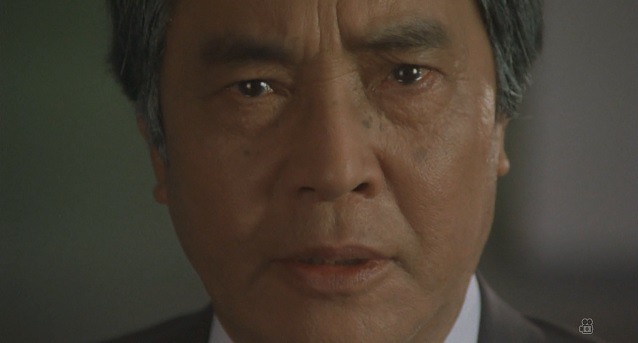
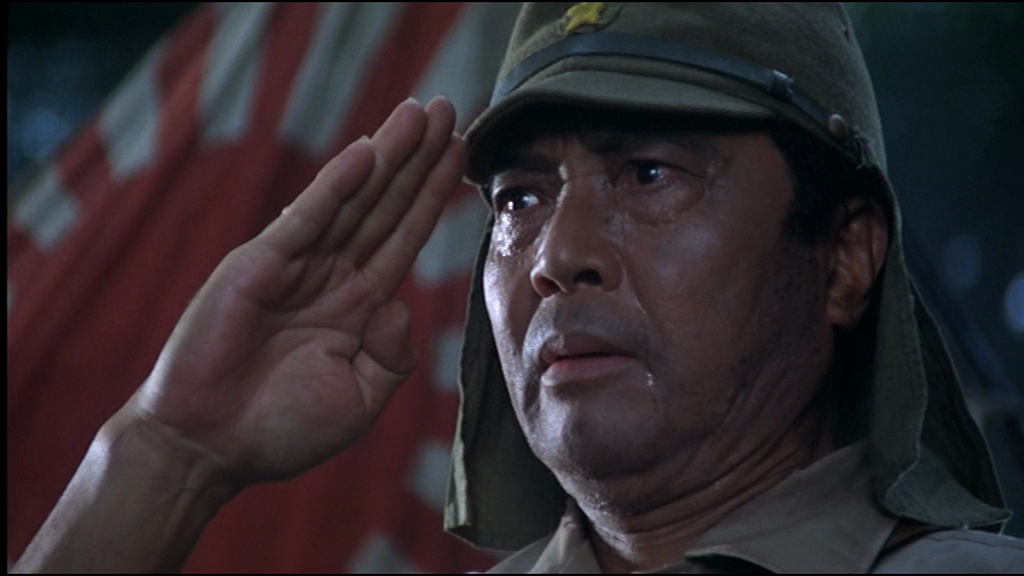 Sasaki is not the only familiar face in this film. Yoshio Tsuchiya, the eccentric actor whom we haven't seen since Destroy All Monsters, returns here as Yasuaki Shindo, who could be the best character he ever played in the entire franchise. He has the most personal relationship with Godzilla of any human character in the series. When he was a commander of the Japanese garrison on Lagos Island in World War II, he and his troops were saved from the Americans by the intervention of the dinosaur that would eventually become Godzilla. He's remained forever grateful to the creature because not only was he able to return to Japan but also to become a powerful businessman and bring his country back from the brink and turn it into one of the wealthiest nations in the world. Because of that, you can understand why he's visibly shocked when Terasawa tells him of his theory that the dinosaur later became Godzilla, a creature that has often threatened Japan's entire existence, let alone its prosperity. But, despite this, later in the film when King Ghidorah is wreaking havoc across the country and it appears that recreating Godzilla is Japan's only hope, Shindo is more than happy to supply the nuclear materials necessary to make it happen, revealing to the government that he secretly owns a nuclear submarine. While everyone else is appalled by this revelation, and leading physicist Fujio feels that the entire idea of bringing Godzilla back to life after they've just rid themselves of him is insane, Shindo insists that there's no other way to save Japan and reiterates how Godzilla once saved his life. In fact, when Godzilla does come back to face King Ghidorah, Shindo still sees him a savior and feels that he's returned to protect everyone once again. Needless to say, that attitude quickly diminishes when Godzilla defeats Ghidorah and it becomes clear that Japan is now in danger from him once again. Feeling partly responsible, since the nuclear submarine he himself sent out made Godzilla even more powerful than the sunken one that actually spurred his recreation, Shindo decides to remain in his office in the Shinjuku district of Tokyo when Godzilla arrives and he waits for him to reach his building, which he does. Shindo knows that he'll be killed but I think this is what he wants, since he probably sees the prosperity and wealth that he built being destroyed by the very creature that enabled him to do so not only as ironic, as he himself says, but, again, as his fault. That leads into a very haunting scene where Shindo literally comes face to face with Godzilla, the two of them meeting for the first time since World War II, as Godzilla stands outside of his office building. Shindo is clearly in tears when he sees what his savior has become but, again, feeling that he's responsible, accepts his fate, apparently motioning for Godzilla, who also recognizes him, with a nod of the head to kill him, which the monster does blasting him head on and demolishing the building.
Sasaki is not the only familiar face in this film. Yoshio Tsuchiya, the eccentric actor whom we haven't seen since Destroy All Monsters, returns here as Yasuaki Shindo, who could be the best character he ever played in the entire franchise. He has the most personal relationship with Godzilla of any human character in the series. When he was a commander of the Japanese garrison on Lagos Island in World War II, he and his troops were saved from the Americans by the intervention of the dinosaur that would eventually become Godzilla. He's remained forever grateful to the creature because not only was he able to return to Japan but also to become a powerful businessman and bring his country back from the brink and turn it into one of the wealthiest nations in the world. Because of that, you can understand why he's visibly shocked when Terasawa tells him of his theory that the dinosaur later became Godzilla, a creature that has often threatened Japan's entire existence, let alone its prosperity. But, despite this, later in the film when King Ghidorah is wreaking havoc across the country and it appears that recreating Godzilla is Japan's only hope, Shindo is more than happy to supply the nuclear materials necessary to make it happen, revealing to the government that he secretly owns a nuclear submarine. While everyone else is appalled by this revelation, and leading physicist Fujio feels that the entire idea of bringing Godzilla back to life after they've just rid themselves of him is insane, Shindo insists that there's no other way to save Japan and reiterates how Godzilla once saved his life. In fact, when Godzilla does come back to face King Ghidorah, Shindo still sees him a savior and feels that he's returned to protect everyone once again. Needless to say, that attitude quickly diminishes when Godzilla defeats Ghidorah and it becomes clear that Japan is now in danger from him once again. Feeling partly responsible, since the nuclear submarine he himself sent out made Godzilla even more powerful than the sunken one that actually spurred his recreation, Shindo decides to remain in his office in the Shinjuku district of Tokyo when Godzilla arrives and he waits for him to reach his building, which he does. Shindo knows that he'll be killed but I think this is what he wants, since he probably sees the prosperity and wealth that he built being destroyed by the very creature that enabled him to do so not only as ironic, as he himself says, but, again, as his fault. That leads into a very haunting scene where Shindo literally comes face to face with Godzilla, the two of them meeting for the first time since World War II, as Godzilla stands outside of his office building. Shindo is clearly in tears when he sees what his savior has become but, again, feeling that he's responsible, accepts his fate, apparently motioning for Godzilla, who also recognizes him, with a nod of the head to kill him, which the monster does blasting him head on and demolishing the building.
 |
| From left to right on the right: Grenchiko, Wilson, and Emmy. |
 The one person in the film whose motivations have always been rather confusing to me is Emmy (Anna Nakagawa), the third person from the future and the one who turns against her comrades in order to save Japan. For the first half of the film, she goes along with Wilson and Grenchiko's plan and is even the one lets the Dorats out of the time machine in 1944 so they will be mutated by the H-Bomb and merge into King Ghidorah. However, when her comrades make it clear that they intend to use Ghidorah to virtually decimate the entire country save for Tokyo, she turns against them, saying that they've gone too far, and begins working with the humans to fight back against them, destroying the computer they're using to control Ghidorah. In the English dub version, her dialogue causes her actions to come across as completely nonsensical. When Wilson first says that he intends to destroy all of Japan, she suddenly protests, saying that they came back to warn the people of Japan that their country was in danger and that they've double-crossed them by using the monster to attack them. Seems sensible enough, until you remember how Emmy intentionally left the Dorats behind to become Ghidorah, and it makes even less sense when Emmy reveals the truth about the future to Terasawa, that Godzilla never does destroy Japan and that it, in fact, becomes one of the most powerful nations in the world. In the Japanese version, though, things make a little more sense. Emmy says that she wants all of the world's countries to live together in unity and equality, agreeing that her home country has become too powerful to ensure this, which is why she went along with the plan to create Ghidorah. As David Kalat says, she expected Wilson and Grenchiko to use Ghidorah as a means of blackmailing Japan into going along with their plan of subjugation, not unleash it upon the country without warning and have it destroy several large cities before finally issuing their ultimatum. In short, she has the same motivation as her comrades but feels that their methods are barbaric. I'd go along with that if it weren't for a confusing bit of dialogue in the aforementioned scene between Emmy and her comrades when she actually berates them for their use of blackmail! Um, huh? Isn't that what you originally wanted to use Ghidorah for? If not, then why did you turn against your comrades? And what's more, there's a line in the Japanese version where Emmy says that Wilson's plan was to have a monster in the 20th century that could destroy Japan, implying that she knew what he was going to do along. God, what is it that she wants?! I get that real people do have complex, multilayered motivations but this is confusing, to say the least. And what's more, at the end of the film when she saves Japan from being completely destroyed by Godzilla (or not, given the ending), she just goes back to her own time, even though, as it is, Japan still has the potential to become too powerful for its own good. I went back to the film to see if I missed anything but, after doing so, it doesn't seem like I did. It could be possible that some of the translating done for the subtitles in my particular copy of the Japanese version was incorrect but, regardless, it still sucks that Emmy's motivations are so clouded because Nakagawa does do a good acting job and it is possible to come to like the character, especially when she becomes very proactive against both her former comrades and Godzilla.
The one person in the film whose motivations have always been rather confusing to me is Emmy (Anna Nakagawa), the third person from the future and the one who turns against her comrades in order to save Japan. For the first half of the film, she goes along with Wilson and Grenchiko's plan and is even the one lets the Dorats out of the time machine in 1944 so they will be mutated by the H-Bomb and merge into King Ghidorah. However, when her comrades make it clear that they intend to use Ghidorah to virtually decimate the entire country save for Tokyo, she turns against them, saying that they've gone too far, and begins working with the humans to fight back against them, destroying the computer they're using to control Ghidorah. In the English dub version, her dialogue causes her actions to come across as completely nonsensical. When Wilson first says that he intends to destroy all of Japan, she suddenly protests, saying that they came back to warn the people of Japan that their country was in danger and that they've double-crossed them by using the monster to attack them. Seems sensible enough, until you remember how Emmy intentionally left the Dorats behind to become Ghidorah, and it makes even less sense when Emmy reveals the truth about the future to Terasawa, that Godzilla never does destroy Japan and that it, in fact, becomes one of the most powerful nations in the world. In the Japanese version, though, things make a little more sense. Emmy says that she wants all of the world's countries to live together in unity and equality, agreeing that her home country has become too powerful to ensure this, which is why she went along with the plan to create Ghidorah. As David Kalat says, she expected Wilson and Grenchiko to use Ghidorah as a means of blackmailing Japan into going along with their plan of subjugation, not unleash it upon the country without warning and have it destroy several large cities before finally issuing their ultimatum. In short, she has the same motivation as her comrades but feels that their methods are barbaric. I'd go along with that if it weren't for a confusing bit of dialogue in the aforementioned scene between Emmy and her comrades when she actually berates them for their use of blackmail! Um, huh? Isn't that what you originally wanted to use Ghidorah for? If not, then why did you turn against your comrades? And what's more, there's a line in the Japanese version where Emmy says that Wilson's plan was to have a monster in the 20th century that could destroy Japan, implying that she knew what he was going to do along. God, what is it that she wants?! I get that real people do have complex, multilayered motivations but this is confusing, to say the least. And what's more, at the end of the film when she saves Japan from being completely destroyed by Godzilla (or not, given the ending), she just goes back to her own time, even though, as it is, Japan still has the potential to become too powerful for its own good. I went back to the film to see if I missed anything but, after doing so, it doesn't seem like I did. It could be possible that some of the translating done for the subtitles in my particular copy of the Japanese version was incorrect but, regardless, it still sucks that Emmy's motivations are so clouded because Nakagawa does do a good acting job and it is possible to come to like the character, especially when she becomes very proactive against both her former comrades and Godzilla. 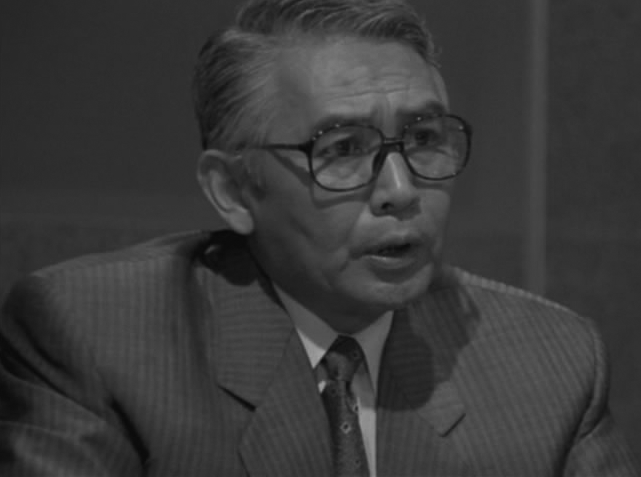
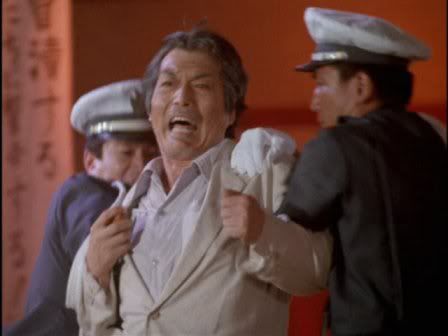 Rounding out the cast are the characters of Fujio (Tokuma Nishioka) and Dobashi (Shoji Kobayashi). Fujio is a physicist from the Ultra-Science Institute who is assigned to help the government in their investigation of the UFO and is the one who makes it clear to them that it is indeed a flying saucer of some sorts. He and Dobashi, who's the government's Security Agency Chief, are the ones who arrange the meeting between the people from the future and government officials, including the prime minister. Fujio doesn't do much else in the film, though, except sit around and listen to information as it comes in, although he is notable in being the one who decries the very idea of bringing Godzilla back to life after they just got rid of him and is also the most appalled by Shindo's owning a nuclear submarine. The same goes for Dobashi, although he's more memorable since he often gets really excited or freaked out (that happens more often in the next film, which he also appears in, though) and he's also the one who suggests that maybe they could recreate Godzilla from the dinosaur in the Bering Sea to help them against King Ghidorah. I also like the line he says when Godzilla has defeated Ghidorah and is clearly going to start attacking Japan again: "Is this your idea of a savior, Shindo?" Oh, and guess who's back in the series? Our old buddy, Kenji Sahara, who has a small role here as one of the government minister (David Kalat lists him as the prime minister in his book's chapter on the film but I think that another actor named So Yamamura, a gentleman with a moustache and glasses in the film, is the one playing that role). Told you he wouldn't stay away from it for long. The same goes for Koichi Ueda, the version of Sahara for the latter half of the series who first appeared in the previous film, appearing here as the soldier whose claims about a dinosaur spike Terasawa's interest, telling him the whole story and explaining why there never was a report made about the incident.
Rounding out the cast are the characters of Fujio (Tokuma Nishioka) and Dobashi (Shoji Kobayashi). Fujio is a physicist from the Ultra-Science Institute who is assigned to help the government in their investigation of the UFO and is the one who makes it clear to them that it is indeed a flying saucer of some sorts. He and Dobashi, who's the government's Security Agency Chief, are the ones who arrange the meeting between the people from the future and government officials, including the prime minister. Fujio doesn't do much else in the film, though, except sit around and listen to information as it comes in, although he is notable in being the one who decries the very idea of bringing Godzilla back to life after they just got rid of him and is also the most appalled by Shindo's owning a nuclear submarine. The same goes for Dobashi, although he's more memorable since he often gets really excited or freaked out (that happens more often in the next film, which he also appears in, though) and he's also the one who suggests that maybe they could recreate Godzilla from the dinosaur in the Bering Sea to help them against King Ghidorah. I also like the line he says when Godzilla has defeated Ghidorah and is clearly going to start attacking Japan again: "Is this your idea of a savior, Shindo?" Oh, and guess who's back in the series? Our old buddy, Kenji Sahara, who has a small role here as one of the government minister (David Kalat lists him as the prime minister in his book's chapter on the film but I think that another actor named So Yamamura, a gentleman with a moustache and glasses in the film, is the one playing that role). Told you he wouldn't stay away from it for long. The same goes for Koichi Ueda, the version of Sahara for the latter half of the series who first appeared in the previous film, appearing here as the soldier whose claims about a dinosaur spike Terasawa's interest, telling him the whole story and explaining why there never was a report made about the incident.As I mentioned in the review of Godzilla vs. Biollante, Godzilla vs. King Ghidorah, despite not getting an American release of any kind until 1998, stirred up quite a bit of controversy over here not too long after its Japanese theatrical release. A cable news network got wind of the film's content and had a rather lengthy show dedicated to debating the film's perceived anti-American sentiments, using the footage of the dinosaur that was to become Godzilla trampling American soldiers during the World War II section and the fact that the two human villains are Caucasian as their evidence. Kazuki Omori, however, staunchly defended the film, saying that he never intended for the film to be a slight against American in any way and, indeed, it is now believed that the controversy was mainly a result of a lot of economic tension between the United States and Japan at the time, with newspapers and magazines like the Washington Times and USA Today commenting on how Japan seemed to be buying up every enterprise they could get their hands on. In other words, it was simply bad luck that a film depicting what this one does was made during a period like this. Sure enough, if those commentators had looked at other aspects of the film (I sincerely doubt they watched the whole thing), they would have seen that the situation depicted here is more complex than one of anti-Americanism. The film may have Western bad guys but it doesn't let Japan itself off the hook either. Even though I find her characterization to be, in the end, muddled, Emmy, a Japanese woman, is one of those who feels that Japan's swelling economy needs to be put under control in order for there equality amongst all nations and, by extension, peace. It's only when she sees that her comrades are using King Ghidorah to attack and kill hundreds of innocent people without warning and without putting their ultimatum out there that she turns against them and tries to stop them. Moreover, the film takes a direct swipe at what Tomoyuki Tanaka once described as, "The vain symbols of these abundant days,": the enormous skyscrapers in Tokyo's Shinjuku District. Like I said during my review of The Return of Godzilla, Tanaka was interested in showing how easily the wealth that Japan had accumulated over the years could easily be undone by either a random act of nature, as in an earthquake, war, like the atomic bombings of Hiroshima and Nagasaki, or, in the case of the movie universe, an enormous creature like Godzilla. In this film, you have the scene where Godzilla kills Shindo, the man behind Japan's prosperity and wealth, along with the enormous City Hall Building in Shinjuku that many Japanese citizens hate because they see it as nothing more but an overblown symbol of Japan's wealth, one that, as we see here, can be very easily destroyed. Godzilla, however, is just like Japan's wealth: if he's left unchecked, he'll cause chaos and disaster throughout the world. Both of these forces need to be contained, which is why Emmy takes it upon herself to battle and, or at least she thinks she does, defeat Godzilla during the film's climax (although, as I said earlier, by the end of the movie, Japan can still potentially become the mega-power she hopes that it doesn't).
Speaking of Godzilla, Omori makes a statement that, while he may have originally been an unforeseen result of the atomic tests, by this point in time it's impossible to keep him from being created, even if you try to completely erase his existence, because of widespread nuclear pollution. As Grenchiko himself says when Godzilla returns to Japan, while nuclear weapons have been completely banned by the time of the era in which they come from, in this day and age, there's so much nuclear material scattered throughout the Earth that it didn't matter where they teleported the dinosaur. He was going to become Godzilla no matter what. And that's another thing. Emmy's revelation that Japan is fated to become a huge, powerful nation and that their story about Godzilla completely devastating it was a lie can only mean one thing: in that timeline, Godzilla eventually died! Even at the beginning of the film, Miki Saegusa herself says that Godzilla is still weak from the effects of the Anti-Nuclear Energy Bacteria and his fight with Biollante and it seems like, if Japan had refused the offer of the people from the future, Godzilla would have expired somewhere off in the sea and the country would never have to suffer at his hands ever again. But, by allowing them to go back in time and mess with history, they've now ended up with a Godzilla who's even more powerful and angry than the one they dealt with before, one who will continue to threaten mankind for a few more tense years and eventually reach the point in Godzilla vs. Destoroyah where his out of control nuclear energy will threaten to burn a hole right through the center of the planet! We always seem to make things worse for ourselves.
Unfortunately, those two issues lead us into something that Godzilla vs. King Ghidorah is completely riddled with: plotholes. I understand that no movie is a perfect and that you're going to make errors in either the script or actual filming no matter how much you try to prepare but, there are so many issues with the film's story and logic that it serves as a testament to how weak Kazuki Omori is as an actual storyteller as opposed to the subtext, themes, and issues that he layers within his films. Let's start with the issue of Godzilla having been weakened by the events of the previous film because this flies into the face of what we saw at the end there. Godzilla may have been literally brought to his knees as a result of his battle with Biollante and the effects of the Anti-Nuclear Energy Bacteria but when he came up out of the water and swam off at the end of that movie, he seemed to be perfectly fine and Dr. Kirishima said that the water lowered his body temperature, rendering the bacteria useless. So, why is he suddenly incapacitated somewhere in the Pacific Ocean, to the point where, as Emmy implies, he'll eventually die from the bacteria's effects? Did he go somewhere hot, which raised his temperature again? Now, let's talk about the plan of the people from the future which, when you really think about it, is more complicated than it needs to be. First off, instead of transporting the dinosaur to another location in order to avoid his future mutation, why not just bring one of those laser guns we later see that you have onboard your ship and blow his brains out with it after he's been severely wounded? Heck, since he's just a dinosaur and not yet Godzilla, you could bring a normal gun and shoot him in the head point-blank. Bang! He's dead. You don't have to worry about him encountering nuclear materials anywhere else in the world. Second, what was the purpose of bringing Terasawa, Miki Saegusa, and Prof. Mazaki with them on this trip into the past? They don't do anything except just sit around and watch (even Mazaki comments when they get back that M-11 and Emmy did all the work). In fact, Miki notices before they leave that the Dorats are gone and brings this up to the others, prematurely revealing that the people from the future are behind King Ghidorah's creation and rampage. For that matter, as David Kalat points out, was it necessary for them to go through the trouble of erasing Godzilla from history and creating King Ghidorah in the first place? For one, they knew from the beginning that Godzilla would never destroy Japan and, therefore, wouldn't have posed a problem for them in the first place, so the plan to eliminate him from history feels pointless (and it ultimately backfired on them too). For another, we're talking about people who not only have a time-machine but also have a really tough android in the form of M-11, as well as maybe a dozen other androids, highly advanced laser guns, a ship that can't even be scratched by bombs, a transporting device, and God knows what else that we don't ever see. I doubt Japan would put up much resistance when they realize how outmatched they are and that even Godzilla is incapable of helping them. Did they really need to go through the trouble of creating another monster to do their dirty work? But we haven't even scratched the surface in terms of how poorly thought out this movie can get.
I'm not a fan of time-travel stories in general. In fact, the only examples I can think of that I do really like are the Terminator movies but, other than that, I typically find them to be very confusing with their pseudoscience and all-around illogical nature. Plus, they always seem to mess things up when it comes to the very logic that they've come up with for their story. If you've been reading my reviews for a while, you know that I can typically go along with anything in a science fiction or fantasy framework, no matter how insane it is (I'd never be a fan of this franchise if I couldn't), but stuff involving time-travel in any form almost always causes me to think too hard and become extremely nitpicky where I otherwise wouldn't be. A Godzilla movie involving time-travel is not immune, especially one that has as many errors as this one does. This stuff didn't bug me at all when I was a kid but when I got older, it started to become an issue to the point where my liking of this movie went down a few notches. For example, when the dinosaur is moved away from Lagos Island, it seems more like Godzilla has simply disappeared rather than be erased from history. Why do I say that? Because everyone still remembers him and comments on how he's suddenly disappeared! What's more, Terasawa is still going ahead with his planned book on Godzilla, even though his publishers should be questioning him as to what a "Godzilla" is, and Miki Saegusa still works for the Godzilla Countermeasures Unit, even though there shouldn't be one (if anything, there should be a King Ghidorah Countermeasures Unit but we'll get to that in a second). You have people talking about recreating Godzilla by blasting the dinosaur in the Bering Sea with radioactivity, despite the fact that they shouldn't even know what this would accomplish or even about the dinosaur period. And when Godzilla is recreated and returns to Japan, everyone comments on how he's bigger and more powerful than he was before, and Shindo still knows that this is the same creature that saved his life back in 1944. Another example concerns Grenchiko's explanation that the reason they can't bring Shindo or any surviving members of the Lagos garrison with them on their trip to the past is because the same person or persons can't exist in the same period in time more than once. I'm going to ignore the fact that means they would have had to have been really careful about when they returned to 1992 so as not to cause that problem with the three people they took with them and head straight to the heart of the matter. When Godzilla critically injures King Ghidorah at the end of their fight, it falls into the ocean, where it's revived as the cyborg Mecha-King Ghidorah by Emmy and M-11 centuries later and then brought back to 1992 in order to stop the rampaging Godzilla. Well, with the cyborg being present at the same time as when its original flesh-and-blood incarnation is lying at the bottom of the ocean, that means there are indeed two Ghidorahs at the same place and time and what's more, the film ends with Mecha-King Ghidorah being dropped into the ocean with Godzilla, now causing there to be two of them down there at the same time as well.
Speaking of King Ghidorah, if it was created by the H-Bomb in 1954 instead of Godzilla, shouldn't it have become Japan's ultimate monster terror over the years instead of just suddenly showing up out of nowhere in 1992? Shouldn't everyone in Japan already know what it is and have formed a countermeasures unit dedicated to it? Did it just sit around like an idiot all those years until the people from the future took control of it and ordered it to attack Japan? In a similar vein, some people have said that Godzilla's removal from history and subsequent rebirth thanks to the nuclear submarines is how he was able to reappear in 1984 despite having been disintegrated into nothing by the Oxygen Destroyer at the end of the original movie. Well, if that's the case, then why is everyone surprised to find evidence of him being reborn in 1992 when they thought he was gone? When we first see him in the film narrative-wise, why was he messing around the spot in the Bering Sea where the dinosaur was dropped? If that's how he managed to show up in 1984, then how did he end up beneath the volcanic crust of Daikoku Island at the beginning of The Return of Godzilla? Why is he now even bigger and more powerful than he was in the previous two films? And, of course, we'd be back to the whole issue of the Anti-Nuclear Energy Bacteria and Biollante having weakened him to the point where he'd no longer pose a threat in the timeline. This time-travel thing would also continue to cause problems as the Heisei series went on. In 1994's Godzilla vs. SpaceGodzilla, one of the theories given for the creation of Godzilla's alien clone is that a fragment of Biollante containing Godzilla's cells got pushed out into space and got swallowed up by a black hole, etc. Given this alteration of the time-line, Biollante should have never existed and, therefore, shouldn't have even been a candidate for this theory. And then, in Godzilla vs. Destoroyah, which was also written by Kazuki Omori, we have the antagonistic monster having been created by the effects of the Oxygen Destroyer when it was used to kill the first Godzilla in 1954... which, now, shouldn't have even happened since the dinosaur fated to become the "first" Godzilla was moved and became the Godzilla they're now dealing with, meaning that Dr. Serizawa had no reason to reveal his invention to the world until he was good and ready. Man, my brain cells are smoking right now! Do you now get why I hate time-travel so much?

 There seems to be more anger within Godzilla in this movie than there was previously. He may not have been warm and cuddly in the previous two films but here, the Big G seems to be filled with even more rage than he ever has been before, probably a result of the modern nuclear weapons that made him bigger and more powerful this time around. When he battles King Ghidorah and attacks a couple of cities, it seems like this time he's not doing so out of defense and whatnot but more like he really wants to cause destruction and suffering, particularly when he blows off Ghidorah's middle head and when he blows up a bunch of buildings along with the military vehicles that fired upon him during his attack on Sapporo. There are also a number of close-ups of Godzilla's face where you see an expression of pure hatred and rage. Just look at the way he snarls at the downed Mecha-King Ghidorah when he closes in for the kill near the end of the film (that's the image on the bottom). It's interesting to note that, despite his rage, Godzilla plays the role of both hero and villain in this film without ever changing his behavior. He saves Japan from Ghidorah simply because he comes across the dragon while stomping through the Japanese and decides to fight it when it threatens him. And then, after he's finished the dragon off, he begins menacing Japan, which is what he would have done in the first place if he hadn't run into Ghidorah. Even though Kenpachiro Satsuma had intended to create a more animal-like portrayal of Godzilla for the Heisei series, there are hints of anthropomorphism throughout this film and I'm not just talking about his anger. For one, there's a moment during his battle with Ghidorah where Godzilla begins slamming the dragon's body up and down by his two tails, which is a move that we saw him do in the 70's when he was more humanlike than animal. Granted, he doesn't act as goofy while doing that as he did back then, and the monster battles in the film otherwise consist of the beam exchanges and more animalistic fighting that would come to dominate the Heisei series, but that moment is still a standout given what they were trying to accomplish with this second cycle of films. However, the moment where Godzilla shows the most human emotion so far in this second series is when he encounters Shindo in his office building down in the Shinjuku District. Upon seeing him, Godzilla at first has the same nasty glare on his face that he's had for most of the film but then, when he looks at Shindo and we can tell that he realizes who he is when see a quick shot of him when he was a commander in the military, Godzilla's demeanor softens a little bit and you can even see tears welling up in his eyes. However, this heartwarming moment is short-lived when Godzilla suddenly roars and shoots his atomic blast directly at Shindo before utterly demolishing the building. There are so many ways to interpret why Godzilla did that. Maybe he recognized that Shindo wanted him to kill him for his part in making him what he is and his roar before doing so was a mournful one. Maybe when thinking back he remembered how Shindo and the garrison left him there to die and killed him out of vengeance and anger. Or maybe Godzilla is downright confused by the emotions he's feeling and kills Shindo to clear his head to where he continue destroying Tokyo. However you wish to interpret it, this moment makes one thing clear: Godzilla is a much more complex character than just a mindless, rampaging monster.
There seems to be more anger within Godzilla in this movie than there was previously. He may not have been warm and cuddly in the previous two films but here, the Big G seems to be filled with even more rage than he ever has been before, probably a result of the modern nuclear weapons that made him bigger and more powerful this time around. When he battles King Ghidorah and attacks a couple of cities, it seems like this time he's not doing so out of defense and whatnot but more like he really wants to cause destruction and suffering, particularly when he blows off Ghidorah's middle head and when he blows up a bunch of buildings along with the military vehicles that fired upon him during his attack on Sapporo. There are also a number of close-ups of Godzilla's face where you see an expression of pure hatred and rage. Just look at the way he snarls at the downed Mecha-King Ghidorah when he closes in for the kill near the end of the film (that's the image on the bottom). It's interesting to note that, despite his rage, Godzilla plays the role of both hero and villain in this film without ever changing his behavior. He saves Japan from Ghidorah simply because he comes across the dragon while stomping through the Japanese and decides to fight it when it threatens him. And then, after he's finished the dragon off, he begins menacing Japan, which is what he would have done in the first place if he hadn't run into Ghidorah. Even though Kenpachiro Satsuma had intended to create a more animal-like portrayal of Godzilla for the Heisei series, there are hints of anthropomorphism throughout this film and I'm not just talking about his anger. For one, there's a moment during his battle with Ghidorah where Godzilla begins slamming the dragon's body up and down by his two tails, which is a move that we saw him do in the 70's when he was more humanlike than animal. Granted, he doesn't act as goofy while doing that as he did back then, and the monster battles in the film otherwise consist of the beam exchanges and more animalistic fighting that would come to dominate the Heisei series, but that moment is still a standout given what they were trying to accomplish with this second cycle of films. However, the moment where Godzilla shows the most human emotion so far in this second series is when he encounters Shindo in his office building down in the Shinjuku District. Upon seeing him, Godzilla at first has the same nasty glare on his face that he's had for most of the film but then, when he looks at Shindo and we can tell that he realizes who he is when see a quick shot of him when he was a commander in the military, Godzilla's demeanor softens a little bit and you can even see tears welling up in his eyes. However, this heartwarming moment is short-lived when Godzilla suddenly roars and shoots his atomic blast directly at Shindo before utterly demolishing the building. There are so many ways to interpret why Godzilla did that. Maybe he recognized that Shindo wanted him to kill him for his part in making him what he is and his roar before doing so was a mournful one. Maybe when thinking back he remembered how Shindo and the garrison left him there to die and killed him out of vengeance and anger. Or maybe Godzilla is downright confused by the emotions he's feeling and kills Shindo to clear his head to where he continue destroying Tokyo. However you wish to interpret it, this moment makes one thing clear: Godzilla is a much more complex character than just a mindless, rampaging monster. The suit used in this film is the same one from Godzilla vs. Biollante and it looks virtually unchanged. I think that, like before, they created some animatronic Godzilla heads for close-ups and these heads look a little bit different than the ones used in the previous film. The heads themselves seem to be a little larger and wider, the eyes appear to have a little more life and emotion to them (although that could be a result of the lighting and filming more than anything else, and the cat-like look of the face appears to have been pulled back a little. And honestly, even though I've been seeing that Godzilla is bigger here than he was in the previous two films, as it's said in the actual movie, I've never noticed much of an increase in his size. He still looks cool and very powerful, mind you, but I think he look virtually the same size nonetheless. The roar is the same as it has been in the previous two movies, this time using more of the version that it took on in Godzilla vs. Biollante, and they also create some new, groaning growls for Godzilla which you hear when he's being strangled by King Ghidorah's middle head and after he destroys the time machine when it's teleported right next to him. His footfalls when he first makes it to land are the same as those of his original dinosaur form, only louder and much more thunderous, and when he's walking through the cities, it's the same, metal slamming ones that we heard during Godzilla's attack on Osaka in the previous film. Again, they sound a little bit louder and thunderous in order to give the impression of Godzilla's increased size and weight.
The suit used in this film is the same one from Godzilla vs. Biollante and it looks virtually unchanged. I think that, like before, they created some animatronic Godzilla heads for close-ups and these heads look a little bit different than the ones used in the previous film. The heads themselves seem to be a little larger and wider, the eyes appear to have a little more life and emotion to them (although that could be a result of the lighting and filming more than anything else, and the cat-like look of the face appears to have been pulled back a little. And honestly, even though I've been seeing that Godzilla is bigger here than he was in the previous two films, as it's said in the actual movie, I've never noticed much of an increase in his size. He still looks cool and very powerful, mind you, but I think he look virtually the same size nonetheless. The roar is the same as it has been in the previous two movies, this time using more of the version that it took on in Godzilla vs. Biollante, and they also create some new, groaning growls for Godzilla which you hear when he's being strangled by King Ghidorah's middle head and after he destroys the time machine when it's teleported right next to him. His footfalls when he first makes it to land are the same as those of his original dinosaur form, only louder and much more thunderous, and when he's walking through the cities, it's the same, metal slamming ones that we heard during Godzilla's attack on Osaka in the previous film. Again, they sound a little bit louder and thunderous in order to give the impression of Godzilla's increased size and weight.  The back of that toy packaging that had descriptions and origins for all of the Godzilla monsters Trendmasters had made action figures out of said that Godzilla himself started out as a creature known as a Godzillasaurus before he was mutated by the H-Bomb. I always found that description to be rather strange because, for one, I didn't yet grasp his nuclear origin, and two, I had never seen or heard this scenario described in any of the movies that I had watched up to that point. It wasn't until I saw this film at the age of ten when I realized that this wasn't a concept that those toy manufacturers had made up, as I originally thought. It is interesting to be able to finally see what Godzilla looked like before he exposed to the radiation of the atomic bomb. The Godzillasaur (Wataru Fukuda), a name that, I might add, was never officially spoken until the 1993 film Godzilla vs. Mechagodzilla II, basically just looks like a regular dinosaur. He looks to me like a smaller, weaker-looking version of a Tyrannosaurus Rex, with some aspects of other dinosaurs like Allosaurus and Iguanadon thrown into the mix as well. As the old man whom Terasawa talked to described, the dinosaur doesn't really attack the American soldiers at first but instead, just sort of slowly walks towards them and drives them back. The deaths that occur are simply the result of his size and girth as he pushes down trees while walking through the jungle than any malicious intent on his part. It's only when he's critically injured after being fired upon by the American battleships that a switch is thrown and he intentionally kills the American soldiers, smashing them with his tail and stomping them with his feet. Speaking of which, even though I said he looks a little weak here, it, nevertheless, seems as though Godzilla was always immune to assault rifles and guns, since the dinosaur simply brushes them off when stomping towards the troops. The exploding shells from the battleships, however, inflict some very nasty, painful, bleeding wounds on him that just about put him down for the count. As the old man also described, the dinosaur is not really protecting the Japanese troops but is simply protecting his territory, similar to how Godzilla himself inadvertently saves Japan when he fights King Ghidorah after being challenged by the dragon. The Godzillasaur's roar is a pretty typical sound that you would expect a dinosaur to make: a deep, trumpeting sort of roar (it kind of sounds like Rodan's roar pitched way down). Weirdly enough, though, when he's fired upon by the American battleships, he starts letting out Gamera's distinctive shriek. I don't know Toho managed to get away with that one but, whatever the case, it's just so weird to hear the sound of Godzilla's biggest rival in Japan come out of the mouth of his unaltered, dinosaur form. The soft, moaning that he lets out when he's lying on the ground seriously injured as the Japanese troops pay their respects is quite sad and you could say that he's doing so not only out of pain but also because he understands that he's about to be left behind, which adds fuel to one of the interpretations of Godzilla's killing of Shindo I mentioned earlier. His footsteps also have a distinctive sound to them that is replicated in a much bigger and more thunderous way when the reborn Godzilla returns to Japan.
The back of that toy packaging that had descriptions and origins for all of the Godzilla monsters Trendmasters had made action figures out of said that Godzilla himself started out as a creature known as a Godzillasaurus before he was mutated by the H-Bomb. I always found that description to be rather strange because, for one, I didn't yet grasp his nuclear origin, and two, I had never seen or heard this scenario described in any of the movies that I had watched up to that point. It wasn't until I saw this film at the age of ten when I realized that this wasn't a concept that those toy manufacturers had made up, as I originally thought. It is interesting to be able to finally see what Godzilla looked like before he exposed to the radiation of the atomic bomb. The Godzillasaur (Wataru Fukuda), a name that, I might add, was never officially spoken until the 1993 film Godzilla vs. Mechagodzilla II, basically just looks like a regular dinosaur. He looks to me like a smaller, weaker-looking version of a Tyrannosaurus Rex, with some aspects of other dinosaurs like Allosaurus and Iguanadon thrown into the mix as well. As the old man whom Terasawa talked to described, the dinosaur doesn't really attack the American soldiers at first but instead, just sort of slowly walks towards them and drives them back. The deaths that occur are simply the result of his size and girth as he pushes down trees while walking through the jungle than any malicious intent on his part. It's only when he's critically injured after being fired upon by the American battleships that a switch is thrown and he intentionally kills the American soldiers, smashing them with his tail and stomping them with his feet. Speaking of which, even though I said he looks a little weak here, it, nevertheless, seems as though Godzilla was always immune to assault rifles and guns, since the dinosaur simply brushes them off when stomping towards the troops. The exploding shells from the battleships, however, inflict some very nasty, painful, bleeding wounds on him that just about put him down for the count. As the old man also described, the dinosaur is not really protecting the Japanese troops but is simply protecting his territory, similar to how Godzilla himself inadvertently saves Japan when he fights King Ghidorah after being challenged by the dragon. The Godzillasaur's roar is a pretty typical sound that you would expect a dinosaur to make: a deep, trumpeting sort of roar (it kind of sounds like Rodan's roar pitched way down). Weirdly enough, though, when he's fired upon by the American battleships, he starts letting out Gamera's distinctive shriek. I don't know Toho managed to get away with that one but, whatever the case, it's just so weird to hear the sound of Godzilla's biggest rival in Japan come out of the mouth of his unaltered, dinosaur form. The soft, moaning that he lets out when he's lying on the ground seriously injured as the Japanese troops pay their respects is quite sad and you could say that he's doing so not only out of pain but also because he understands that he's about to be left behind, which adds fuel to one of the interpretations of Godzilla's killing of Shindo I mentioned earlier. His footsteps also have a distinctive sound to them that is replicated in a much bigger and more thunderous way when the reborn Godzilla returns to Japan.However, as interesting a concept as the Godzillasaur is, there's a major continuity problem with him because he flies in the face of Dr. Yamane's original theory about what Godzilla was in the first film. For one, he felt that Godzilla was of a species that came up in-between the evolution of sea creatures into land animals. The Godzillasaur looks like a completely terrestrial creature judging from his body shape; if he walked off into the ocean, he would almost certainly sink to the bottom like a stone and drown. Furthermore, Yamane speculated that Godzilla probably lived down deep in the ocean, feeding on the other animals that live down there, and was possibly removed from his environment by the same atomic tests that made him intensely radioactive. You may say that was just a theory but if you go back and watch the original Godzilla, Yamane had strong evidence to support it, which was the trilobite found in Godzilla's footprint on Odo Island. Inside that trilobite's shell was sand which they discovered matched the sediment from the stratum that dates far back to the Jurassic period, meaning that Godzilla was indeed living deep down in the ocean, perhaps in a cave, when he was hit by the H-Bomb. Doesn't quite mesh with Terasawa's theory of the dinosaur being mutated on Lagos Island by an atomic test, does it? Methinks Mr. Omori should have watched the original movie again before writing a screenplay that dealt with the alteration of the events leading up to it.
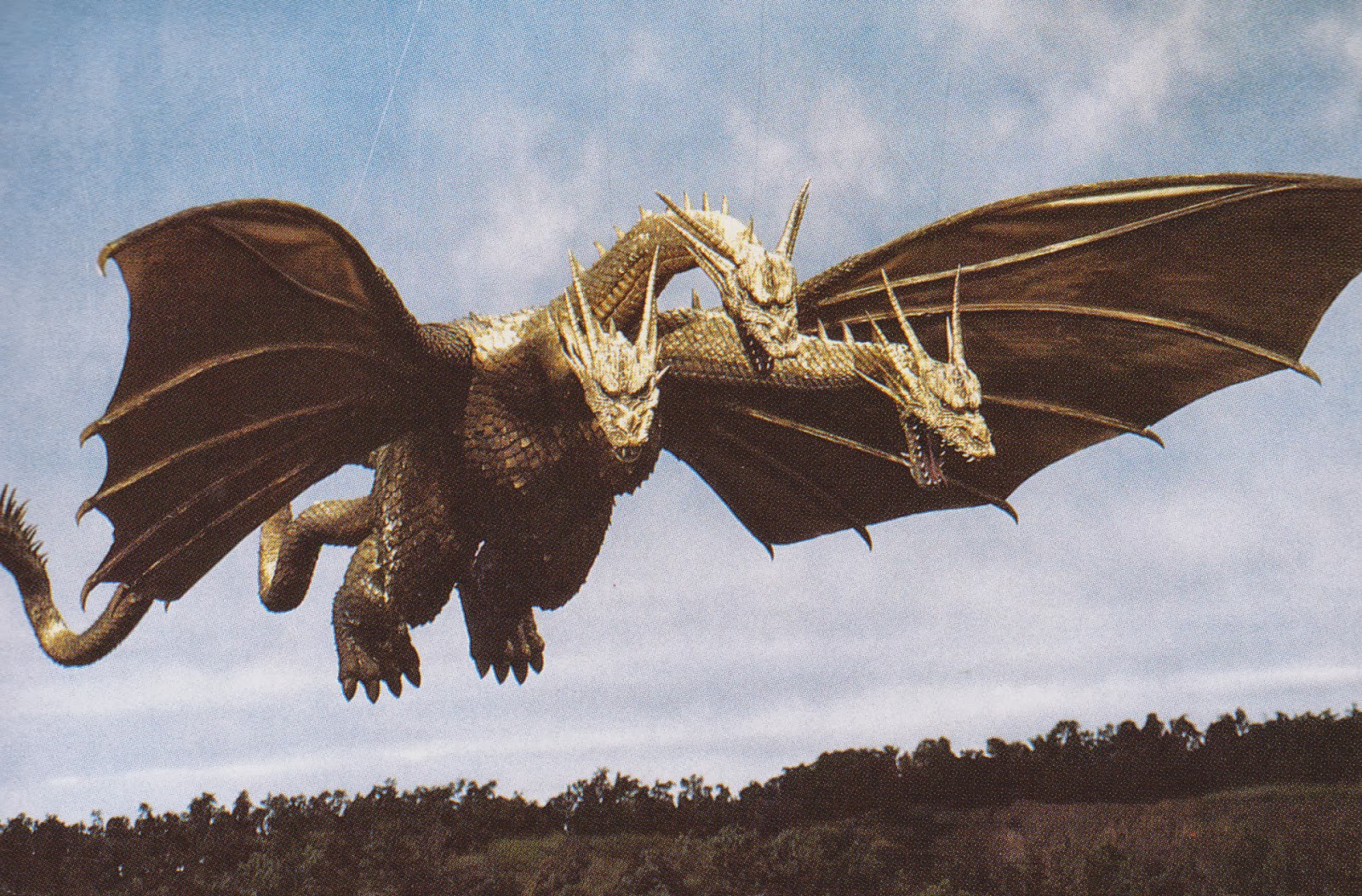
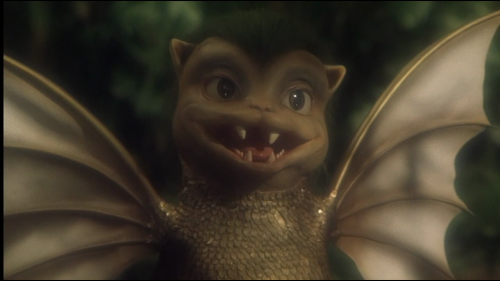 As it was more often than not in the original series, King Ghidorah (Ryu Hurricane) doesn't have much in the way of a discernible personality in this film and is little more than a weapon that the people from the future wield to attack Japan. In fact, the only time we see it acting of its own accord is when it's freed from the control of the time machine's computer Emmy, Terasawa, and M-11 and then, it doesn't really act in a distinctive way and is actually very easily defeated by Godzilla, even though it does manage to almost strangle him by constricting his neck with its middle one. When it's under the control of the computer and the future people are using it to attack cities, it makes for an effective "big gun", causing massive destruction by shooting its lightning bolts all over the place in a random manner and it almost manages to defeat Godzilla before the computer gets blown up. Still, it doesn't act as hyper and manic as it did during its first two appearances in the previous series and, again, it comes across as downright weak when it's released from its control and Godzilla manages to put it down for the count rather easily (this is only the second time when Godzilla does definitively defeat Ghidorah rather than allowing it to fly away). That said, though, I must say that this is one of the few times where I've felt sympathy for Ghidorah, mainly because, like Godzilla, we see what this incarnation of it was before it became the enormous, three-headed dragon. The Dorats are three, cute little flying critters with big, sweet eyes, friendly faces, and they make precious little trilling noises. You find out that they're a new type of animal that's come to be popular a pet in the 23rd century, that they can sense their owners' feelings through psychic wavelengths, and that they are more than willing to make people happy if they're feeling down. This information makes you feel really bad for them when you learn that they're going to be exposed to the atomic bomb and merged together to become a gigantic, ugly monster whose only purpose is to cause death and destruction. For that matter, even though I don't find Ghidorah to have much of a personality when it's freed from the mind control and I also think they made it come across as too weak when Godzilla annihilates it, I do feel kind of bad that it probably didn't understand what was going when its mind was freed and it started getting beaten on by Godzilla. Furthermore, after Godzilla blows its middle head off (in essence, killing one of the three Dorats), the badly injured Ghidorah tries to escape but Godzilla blasts a hole through one of its wings, sending it tumbling down into the ocean. As for its look, I think they gave Ghidorah a really cool, updated design. It keeps the very essence of the monster that we've come to know very well by this point and just makes it feel much larger and more powerful, with a larger girth, stronger-looking body, and ferocious, snarling heads. I like that they got rid of the tufts of hair that were around the original design's heads in favor of big, long horns on the tops and sides of them. Ghidorah is also given a different roar, which sounds like Rodan's roar pitched much higher than usual, making it sound very squeaky as well, and it also comes across as electronically altered to sound more otherworldly.
As it was more often than not in the original series, King Ghidorah (Ryu Hurricane) doesn't have much in the way of a discernible personality in this film and is little more than a weapon that the people from the future wield to attack Japan. In fact, the only time we see it acting of its own accord is when it's freed from the control of the time machine's computer Emmy, Terasawa, and M-11 and then, it doesn't really act in a distinctive way and is actually very easily defeated by Godzilla, even though it does manage to almost strangle him by constricting his neck with its middle one. When it's under the control of the computer and the future people are using it to attack cities, it makes for an effective "big gun", causing massive destruction by shooting its lightning bolts all over the place in a random manner and it almost manages to defeat Godzilla before the computer gets blown up. Still, it doesn't act as hyper and manic as it did during its first two appearances in the previous series and, again, it comes across as downright weak when it's released from its control and Godzilla manages to put it down for the count rather easily (this is only the second time when Godzilla does definitively defeat Ghidorah rather than allowing it to fly away). That said, though, I must say that this is one of the few times where I've felt sympathy for Ghidorah, mainly because, like Godzilla, we see what this incarnation of it was before it became the enormous, three-headed dragon. The Dorats are three, cute little flying critters with big, sweet eyes, friendly faces, and they make precious little trilling noises. You find out that they're a new type of animal that's come to be popular a pet in the 23rd century, that they can sense their owners' feelings through psychic wavelengths, and that they are more than willing to make people happy if they're feeling down. This information makes you feel really bad for them when you learn that they're going to be exposed to the atomic bomb and merged together to become a gigantic, ugly monster whose only purpose is to cause death and destruction. For that matter, even though I don't find Ghidorah to have much of a personality when it's freed from the mind control and I also think they made it come across as too weak when Godzilla annihilates it, I do feel kind of bad that it probably didn't understand what was going when its mind was freed and it started getting beaten on by Godzilla. Furthermore, after Godzilla blows its middle head off (in essence, killing one of the three Dorats), the badly injured Ghidorah tries to escape but Godzilla blasts a hole through one of its wings, sending it tumbling down into the ocean. As for its look, I think they gave Ghidorah a really cool, updated design. It keeps the very essence of the monster that we've come to know very well by this point and just makes it feel much larger and more powerful, with a larger girth, stronger-looking body, and ferocious, snarling heads. I like that they got rid of the tufts of hair that were around the original design's heads in favor of big, long horns on the tops and sides of them. Ghidorah is also given a different roar, which sounds like Rodan's roar pitched much higher than usual, making it sound very squeaky as well, and it also comes across as electronically altered to sound more otherworldly.  That packaging is where I also learned of Ghidorah's cybernetic form, Mecha-King Ghidorah, which I would also get several toys of over the years. However, when I first saw that thing, I was like, "Okay, now I know for sure that they're making this stuff because I've never seen this thing in any Godzilla movie!" But, before Godzilla vs. King Ghidorah was even over during my first viewing of it, I had a feeling that, since this movie had confirmed the alternate origin of Ghidorah involving the Dorats that I had read about, I had a sneaking suspicion that Mecha-King Ghidorah was just around the corner... and I was completely right. While the flesh-and-blood Ghidorah doesn't have much of a characterization in this film, Mecha-King Ghidorah isn't a character at all since it's actually piloted by Emmy and M-11's memory disc serves as its computer system. It's nothing more than a battle vehicle like the Super-X and the Super-X2, which is also what this series' version of Mechagodzilla will be. But, even though it is just a battle vehicle, it's a really cool one. Its design is just awesome, with the robotic middle head and neck, metal chest plate, steel plates around the knees, steel tail-tips, and huge, solar panel-like wings. The middle head fires a powerful plasma beam while the two living heads still fire their lightning bolts but the most powerful weapons lie in the chest plate: four energy-conducting cables that grab onto Godzilla's arms and legs and an enormous claw clamp that grabs his midsection to completely immobilize him. The digitized version of the original Ghidorah's roar that comes out of Mecha-King Ghidorah's middle head is also pretty cool. I'm disappointed that this is the only film that this cyborg monster has ever appeared in because I would have liked to have seen Godzilla have a rematch with it (and, on a side-note, this is a cyborg, not the original Mechagodzilla; sorry but that still bugs me in a nerdy way).
That packaging is where I also learned of Ghidorah's cybernetic form, Mecha-King Ghidorah, which I would also get several toys of over the years. However, when I first saw that thing, I was like, "Okay, now I know for sure that they're making this stuff because I've never seen this thing in any Godzilla movie!" But, before Godzilla vs. King Ghidorah was even over during my first viewing of it, I had a feeling that, since this movie had confirmed the alternate origin of Ghidorah involving the Dorats that I had read about, I had a sneaking suspicion that Mecha-King Ghidorah was just around the corner... and I was completely right. While the flesh-and-blood Ghidorah doesn't have much of a characterization in this film, Mecha-King Ghidorah isn't a character at all since it's actually piloted by Emmy and M-11's memory disc serves as its computer system. It's nothing more than a battle vehicle like the Super-X and the Super-X2, which is also what this series' version of Mechagodzilla will be. But, even though it is just a battle vehicle, it's a really cool one. Its design is just awesome, with the robotic middle head and neck, metal chest plate, steel plates around the knees, steel tail-tips, and huge, solar panel-like wings. The middle head fires a powerful plasma beam while the two living heads still fire their lightning bolts but the most powerful weapons lie in the chest plate: four energy-conducting cables that grab onto Godzilla's arms and legs and an enormous claw clamp that grabs his midsection to completely immobilize him. The digitized version of the original Ghidorah's roar that comes out of Mecha-King Ghidorah's middle head is also pretty cool. I'm disappointed that this is the only film that this cyborg monster has ever appeared in because I would have liked to have seen Godzilla have a rematch with it (and, on a side-note, this is a cyborg, not the original Mechagodzilla; sorry but that still bugs me in a nerdy way). 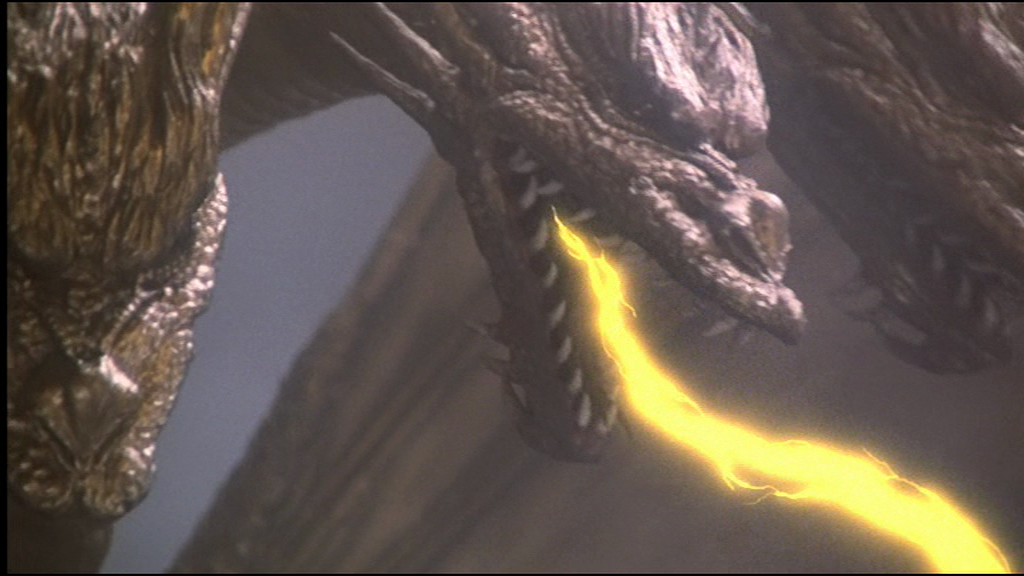

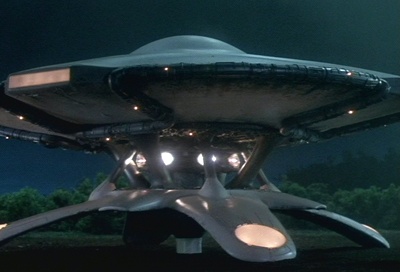
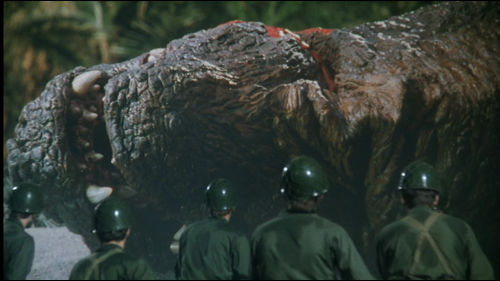

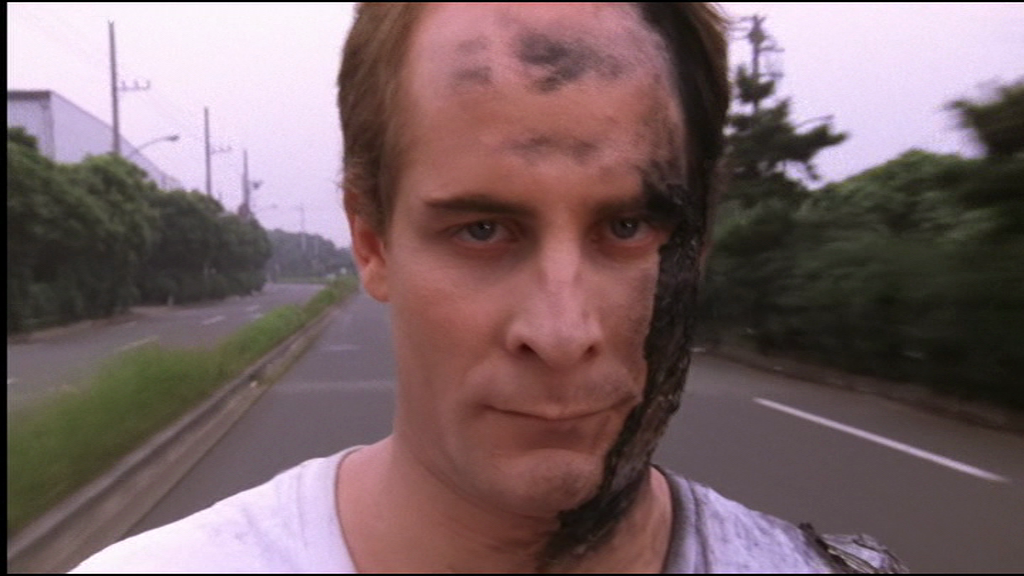 While the effects work for Godzilla vs. Biollante was some of the most flawless this series has ever seen, the stuff in Godzilla vs. King Ghidorah is a little more mixed. As per usual, all of the stuff involving the monsters is top notch, with Godzilla and both versions of King Ghidorah looking like nothing less than two, enormous creatures battling it out (there's not a single, visible wire when Ghidorah is onscreen), the miniature sets and buildings are well designed and detailed (especially the enormous meant to simulate the buildings in the Shinjuku District), as are both the main time machine and the smaller, plane-shaped one that Emmy and M-11 use, and the pyrotechnics and optical effects like Godzilla's atomic blast and Ghidorah's lightning bolts are truly spectacular. However, there are other effects that don't look so great. When M-11 is supposedly running really fast, the shots of him are outright laughable, like when he's "running" amongst the exploding shells on Lagos Island (it looks like he's standing on a hidden conveyor belt and is moving his arms to look like he's running) and when he's chasing after Terasawa and Emmy's jeep later on. The sped-up shots of him running are particularly silly-looking and even more laughable is this shot of his head during that chase sequence with the road and background zipping by. The makeup effects used to simulate his flesh being burnt away to reveal the metal underneath don't look too bad but those running effects, which I wasn't impressed with even when I was ten, are what really hurt it. Some of the matting, like when you see Godzilla in a long shot with other elements like onlookers in the foreground, looks pretty good but then there are others, like when the soldiers are standing around the body of the collapsed Godzillasaur, that are a bit suspect. Also, as cute as they are, the Dorats don't look like anything less than static-looking marionettes when they're flying around and hand-puppets when they're sitting and gesturing around, as well as in close-ups (as we've seen many times by now, puppet effects have never been this series' strong suit). But I think the absolute worst special effect in the film has to go to a shot when Emmy is using this little hover-pack to sneak out of the time machine to go visit Terasawa. When she flies directly at the camera, it's an optical shot that rivals the cheesiness of that notorious one in Jaws 3 where the shark heads straight towards the camera and looks like a static image being pushed forward while doing so. I know their technology at the time probably wasn't as sophisticated as the stuff being done over here but still... wow. Speaking of which, there are some early computer-generated images, such as when they're traveling through time (at least, I think that's CGI), when holograms of objects that are to be transported pop up over the control panel, when something is actually transported, when you see the graphics of the computer that the people of the future plan to give to Japan, and some other holographic effects when the future people first reveal themselves. Some of these latter effects still look pretty cool while others are noticeably dated. Overall, while Koichi Kawakita was certainly a talented effects artist in his day, this film proves that not every film he worked on had absolutely flawless work.
While the effects work for Godzilla vs. Biollante was some of the most flawless this series has ever seen, the stuff in Godzilla vs. King Ghidorah is a little more mixed. As per usual, all of the stuff involving the monsters is top notch, with Godzilla and both versions of King Ghidorah looking like nothing less than two, enormous creatures battling it out (there's not a single, visible wire when Ghidorah is onscreen), the miniature sets and buildings are well designed and detailed (especially the enormous meant to simulate the buildings in the Shinjuku District), as are both the main time machine and the smaller, plane-shaped one that Emmy and M-11 use, and the pyrotechnics and optical effects like Godzilla's atomic blast and Ghidorah's lightning bolts are truly spectacular. However, there are other effects that don't look so great. When M-11 is supposedly running really fast, the shots of him are outright laughable, like when he's "running" amongst the exploding shells on Lagos Island (it looks like he's standing on a hidden conveyor belt and is moving his arms to look like he's running) and when he's chasing after Terasawa and Emmy's jeep later on. The sped-up shots of him running are particularly silly-looking and even more laughable is this shot of his head during that chase sequence with the road and background zipping by. The makeup effects used to simulate his flesh being burnt away to reveal the metal underneath don't look too bad but those running effects, which I wasn't impressed with even when I was ten, are what really hurt it. Some of the matting, like when you see Godzilla in a long shot with other elements like onlookers in the foreground, looks pretty good but then there are others, like when the soldiers are standing around the body of the collapsed Godzillasaur, that are a bit suspect. Also, as cute as they are, the Dorats don't look like anything less than static-looking marionettes when they're flying around and hand-puppets when they're sitting and gesturing around, as well as in close-ups (as we've seen many times by now, puppet effects have never been this series' strong suit). But I think the absolute worst special effect in the film has to go to a shot when Emmy is using this little hover-pack to sneak out of the time machine to go visit Terasawa. When she flies directly at the camera, it's an optical shot that rivals the cheesiness of that notorious one in Jaws 3 where the shark heads straight towards the camera and looks like a static image being pushed forward while doing so. I know their technology at the time probably wasn't as sophisticated as the stuff being done over here but still... wow. Speaking of which, there are some early computer-generated images, such as when they're traveling through time (at least, I think that's CGI), when holograms of objects that are to be transported pop up over the control panel, when something is actually transported, when you see the graphics of the computer that the people of the future plan to give to Japan, and some other holographic effects when the future people first reveal themselves. Some of these latter effects still look pretty cool while others are noticeably dated. Overall, while Koichi Kawakita was certainly a talented effects artist in his day, this film proves that not every film he worked on had absolutely flawless work. The film actually begins in the year 2204 in the Sea of Okhotsk, where a futuristic submarine cruises through the dark water and comes across the body of King Ghidorah, which is missing its middle head. As the two passengers look at the dragon's body, the woman tells the man that Ghidorah lost its middle head when it battled Godzilla in the 20th Century. As the title comes up, we hear Godzilla roar and we can see a little bit of a later standoff between him and Ghidorah behind it. I'm thinking that this was put in there to placate viewers because Godzilla doesn't officially enter the story until over an hour into the film. After that, the story then really begins, in Tokyo in 1992, as the UFO that's later revealed to be a time-machine flies over the city while hundreds of amazed onlookers, including Miki Saegusa, watch it. When it switches to the next day where we're introduced to Terasawa, we see that it's all over the newspapers and magazines, with some grainy photos accompanying the stories. We get more of the UFO a few minutes later when two military helicopters come across the ship as it's resting on the ground near Mt. Fuji. As they go in for a closer look, both helicopters are somehow destroyed by the ship and after that, a squadron of troops deployed to find out what happened comes across the ship as it continues to sit in the middle of a vacant field (oddly enough, though, when the government officials finally meet the people from the future, they never ask them about those two helicopters, even though their ship was suspected to have attacked them). The next day, the military stakes out around the ship, deploying heavy artillery like tanks and large cannons to the site as well in case there's trouble. We then see that the ship sent them a video text message, saying that they've come to speak with the Japanese authorities, and after they read the message, Fujio and Dobashi meet the people from the future for the first time when they beam some holographic images of themselves outside the ship (we then see that they actually are holograms when Fujio and Dobashi attempt to shake their hands and such). That's when they explain that they're from the future rather than aliens, that the UFO is actually a time machine, and, after having the two men arrange it for them, teleport themselves to a meeting with the government officials the next day where they tell them that Godzilla will eventually come back and completely decimate Japan and that they've come to stop him from doing so. After that is when Terasawa, Prof. Mazaki, and Miki Saegusa meet with Fujio and Dobashi at the prime minister's office, where they learn of the plan to go back in time and remove Godzilla from history and that the future people request that the three of them go along on the trip (again, why?) The next day, the three of them are taken to the time machine, which they board, meet with the future people, including Emmy and M-11, are told why they couldn't take someone like Shindo with them, and, after boarding the smaller, plane-like time machine and meet the Dorats, they depart and travel through the time-warp to 1944.
The film actually begins in the year 2204 in the Sea of Okhotsk, where a futuristic submarine cruises through the dark water and comes across the body of King Ghidorah, which is missing its middle head. As the two passengers look at the dragon's body, the woman tells the man that Ghidorah lost its middle head when it battled Godzilla in the 20th Century. As the title comes up, we hear Godzilla roar and we can see a little bit of a later standoff between him and Ghidorah behind it. I'm thinking that this was put in there to placate viewers because Godzilla doesn't officially enter the story until over an hour into the film. After that, the story then really begins, in Tokyo in 1992, as the UFO that's later revealed to be a time-machine flies over the city while hundreds of amazed onlookers, including Miki Saegusa, watch it. When it switches to the next day where we're introduced to Terasawa, we see that it's all over the newspapers and magazines, with some grainy photos accompanying the stories. We get more of the UFO a few minutes later when two military helicopters come across the ship as it's resting on the ground near Mt. Fuji. As they go in for a closer look, both helicopters are somehow destroyed by the ship and after that, a squadron of troops deployed to find out what happened comes across the ship as it continues to sit in the middle of a vacant field (oddly enough, though, when the government officials finally meet the people from the future, they never ask them about those two helicopters, even though their ship was suspected to have attacked them). The next day, the military stakes out around the ship, deploying heavy artillery like tanks and large cannons to the site as well in case there's trouble. We then see that the ship sent them a video text message, saying that they've come to speak with the Japanese authorities, and after they read the message, Fujio and Dobashi meet the people from the future for the first time when they beam some holographic images of themselves outside the ship (we then see that they actually are holograms when Fujio and Dobashi attempt to shake their hands and such). That's when they explain that they're from the future rather than aliens, that the UFO is actually a time machine, and, after having the two men arrange it for them, teleport themselves to a meeting with the government officials the next day where they tell them that Godzilla will eventually come back and completely decimate Japan and that they've come to stop him from doing so. After that is when Terasawa, Prof. Mazaki, and Miki Saegusa meet with Fujio and Dobashi at the prime minister's office, where they learn of the plan to go back in time and remove Godzilla from history and that the future people request that the three of them go along on the trip (again, why?) The next day, the three of them are taken to the time machine, which they board, meet with the future people, including Emmy and M-11, are told why they couldn't take someone like Shindo with them, and, after boarding the smaller, plane-like time machine and meet the Dorats, they depart and travel through the time-warp to 1944. 
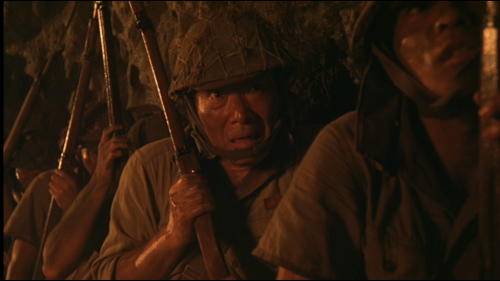
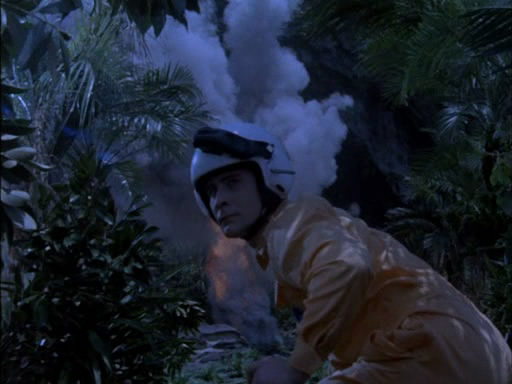 The 1944 section begins with a scene between an American captain and major on one of the battleships stationed near Lagos Island. As they talk about the situation (these two actors suck and suck hard, I might add), they spot the time-machine as it streaks over them and heads towards the island. As they note that it looked like a spaceship, the two men lead into one of the most cringe-inducing jokes that's ever been put to film. The major says, "Shall we report it, sir?", to which the captain replies, "What, that we're being invaded by little green men from outer space? Let's just keep it as our secret. You can tell your son about it when he's born, Maj. Spielberg." Ugh. That joke flew over my head as a kid but now, I sincerely feel that Kazuki Omori should be smacked for writing that. In any case, the time-machine lands in the jungle in the center of the island but, just as Terasawa is about to get up out of his seat, the ship is rocked by a barrage of explosive shells from the battleships. As the ship shakes from the surrounding explosions, which destroy a lot of the surrounding jungle, Terasawa is amazed that they actually traveled back in time but Prof. Mazaki is less enthused since, as he says, it landed them in the middle of World War II. The assault goes on and we see that it's wreaking havoc with the nearby cave hideout of some Japanese troops. The commander, who is revealed as a young Yasuaki Shindo, is informed that all communications have been cut off and he looks his subordinate with a very grim look on his face, as his men shudder from the ongoing explosions. Back at the time machine, Miki, who starts to get really worried about their safety amongst the enormous explosions, is assured by Emmy that the bombs can't damage the ship. M-11 then decides to check outside, since he's as impervious to the bombs as the ship, and that's when we get that laughable shot of him running amongst the explosions like a guy on a conveyor belt. After running and jumping to dodge some more explosions, M-11 arrives at the mouth of the cave, where he watches Shindo giving his troops a rousing speech about how they must not be afraid to follow in the footsteps of the wiped out garrisons of the surrounding islands and fight to ensure their country's victory. As M-11 watches, he uses a remote camera system to allow those back in the ship to see it as well, and Terasawa and Mazaki are amazed when they see the young Shindo.
The 1944 section begins with a scene between an American captain and major on one of the battleships stationed near Lagos Island. As they talk about the situation (these two actors suck and suck hard, I might add), they spot the time-machine as it streaks over them and heads towards the island. As they note that it looked like a spaceship, the two men lead into one of the most cringe-inducing jokes that's ever been put to film. The major says, "Shall we report it, sir?", to which the captain replies, "What, that we're being invaded by little green men from outer space? Let's just keep it as our secret. You can tell your son about it when he's born, Maj. Spielberg." Ugh. That joke flew over my head as a kid but now, I sincerely feel that Kazuki Omori should be smacked for writing that. In any case, the time-machine lands in the jungle in the center of the island but, just as Terasawa is about to get up out of his seat, the ship is rocked by a barrage of explosive shells from the battleships. As the ship shakes from the surrounding explosions, which destroy a lot of the surrounding jungle, Terasawa is amazed that they actually traveled back in time but Prof. Mazaki is less enthused since, as he says, it landed them in the middle of World War II. The assault goes on and we see that it's wreaking havoc with the nearby cave hideout of some Japanese troops. The commander, who is revealed as a young Yasuaki Shindo, is informed that all communications have been cut off and he looks his subordinate with a very grim look on his face, as his men shudder from the ongoing explosions. Back at the time machine, Miki, who starts to get really worried about their safety amongst the enormous explosions, is assured by Emmy that the bombs can't damage the ship. M-11 then decides to check outside, since he's as impervious to the bombs as the ship, and that's when we get that laughable shot of him running amongst the explosions like a guy on a conveyor belt. After running and jumping to dodge some more explosions, M-11 arrives at the mouth of the cave, where he watches Shindo giving his troops a rousing speech about how they must not be afraid to follow in the footsteps of the wiped out garrisons of the surrounding islands and fight to ensure their country's victory. As M-11 watches, he uses a remote camera system to allow those back in the ship to see it as well, and Terasawa and Mazaki are amazed when they see the young Shindo. 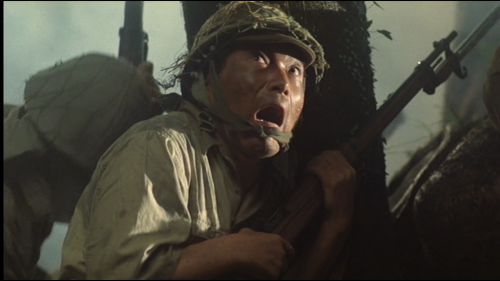
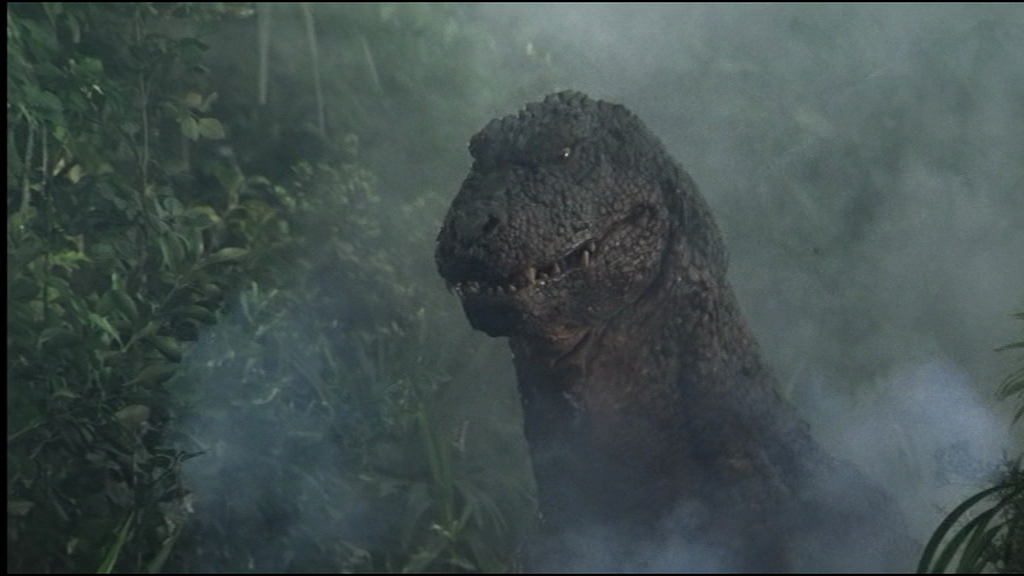
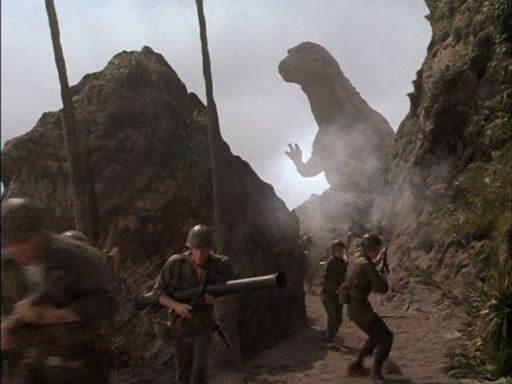
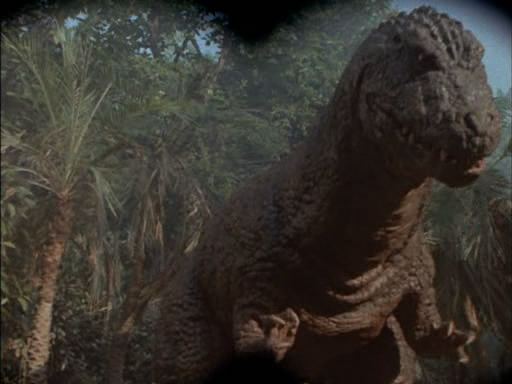
 The next day, the Japanese soldiers launch an all-out attack on the Americans, who have now come ashore and are lurking in the jungle. This course of action, however, proves disastrous for the Japanese as they can do little against the Americans' superior weapons and either get gunned down by their assault rifles or blown up by their bazooka launchers, as those in the time machine watch in horror. But, just when it looks like the Japanese have had, a deep cry suddenly echoes through the jungle and both groups of soldiers are stunned when the Godzillasaur makes his first appearance, stomping through the jungle and heading right for the site of the battle, walking past the cave entrance and an equally stunned Shindo. As the dinosaur lifts his head up and trumpets again, the Americans open fire on him but he wades through the onslaught of their assault rifles and bazookas, forcing the soldiers to fall back through the jungle. As he moves through the brush, the Godzillasaur inadvertently kills a bunch of the soldiers by knocking down tree with his tail and girth, with the soldiers getting caught underneath the trunks as a result, as well as by smacking some with his tail. As the battle goes on, everyone in the time machine disembarks to get a closer look at the action. By this point, the Godzillasaur has chased the soldiers, who continue to fire at him, to the beach, where one soldier radios the command ship about what's going on. Needless to say, the captain's first reaction upon hearing that a dinosaur is attacking the soldiers is, "What?!", but when he looks through one of the ship's periscopes (if that's what they're called when they're on a ship), he gets a good look at him. Seeing that the soldiers are unable to kill the dinosaur and that they're also running out of places to escape to, the captain orders the dinosaur fired upon. The battleships began firing their heavy shells at the Godzillasaur, with one hitting him on the left side of his mouth, causing a spurt of blood in the process. The dinosaur begins screaming in agony as more shells explode around him as well as on him, with one hitting him in the mouth again, while both the time-travelers and Shindo and his troops watch nearby. The Godzillasaur stumbles up to the water's edge, getting hit right in the chest as he does so and as blood pours out of the wound, he falls to the ground, apparently dead. While the Japanese are horrified by this, the Americans celebrate, with Maj. Spielberg saying another awful line: "Take that, you dinosaur," (once again, Mr. Omori, you deserve a smack across the face for that horrible line). The American troops on the beach then circle around the dinosaur in order gawk at him but, as you can expect, they get too close and end up paying for it. His tail swings around and sends some troops flying, as he gets to his feet and angrily stomps on some soldiers (bad matting there, by the way) while smacking more with his tail. After finishing them off, the Godzillasaur, still bloodied and in a lot of pain, turns and staggers back into the jungle. The time-travelers are now sure that this is the creature that will later become Godzilla and decide to go to the day the Japanese garrison left Lagos Island in order to transport him. At the same time, the Americans decide to call off their landing operation and move on.
The next day, the Japanese soldiers launch an all-out attack on the Americans, who have now come ashore and are lurking in the jungle. This course of action, however, proves disastrous for the Japanese as they can do little against the Americans' superior weapons and either get gunned down by their assault rifles or blown up by their bazooka launchers, as those in the time machine watch in horror. But, just when it looks like the Japanese have had, a deep cry suddenly echoes through the jungle and both groups of soldiers are stunned when the Godzillasaur makes his first appearance, stomping through the jungle and heading right for the site of the battle, walking past the cave entrance and an equally stunned Shindo. As the dinosaur lifts his head up and trumpets again, the Americans open fire on him but he wades through the onslaught of their assault rifles and bazookas, forcing the soldiers to fall back through the jungle. As he moves through the brush, the Godzillasaur inadvertently kills a bunch of the soldiers by knocking down tree with his tail and girth, with the soldiers getting caught underneath the trunks as a result, as well as by smacking some with his tail. As the battle goes on, everyone in the time machine disembarks to get a closer look at the action. By this point, the Godzillasaur has chased the soldiers, who continue to fire at him, to the beach, where one soldier radios the command ship about what's going on. Needless to say, the captain's first reaction upon hearing that a dinosaur is attacking the soldiers is, "What?!", but when he looks through one of the ship's periscopes (if that's what they're called when they're on a ship), he gets a good look at him. Seeing that the soldiers are unable to kill the dinosaur and that they're also running out of places to escape to, the captain orders the dinosaur fired upon. The battleships began firing their heavy shells at the Godzillasaur, with one hitting him on the left side of his mouth, causing a spurt of blood in the process. The dinosaur begins screaming in agony as more shells explode around him as well as on him, with one hitting him in the mouth again, while both the time-travelers and Shindo and his troops watch nearby. The Godzillasaur stumbles up to the water's edge, getting hit right in the chest as he does so and as blood pours out of the wound, he falls to the ground, apparently dead. While the Japanese are horrified by this, the Americans celebrate, with Maj. Spielberg saying another awful line: "Take that, you dinosaur," (once again, Mr. Omori, you deserve a smack across the face for that horrible line). The American troops on the beach then circle around the dinosaur in order gawk at him but, as you can expect, they get too close and end up paying for it. His tail swings around and sends some troops flying, as he gets to his feet and angrily stomps on some soldiers (bad matting there, by the way) while smacking more with his tail. After finishing them off, the Godzillasaur, still bloodied and in a lot of pain, turns and staggers back into the jungle. The time-travelers are now sure that this is the creature that will later become Godzilla and decide to go to the day the Japanese garrison left Lagos Island in order to transport him. At the same time, the Americans decide to call off their landing operation and move on. 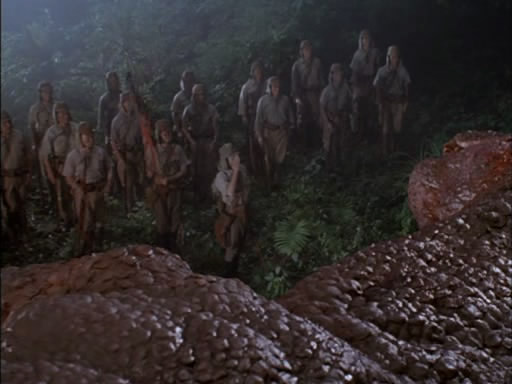
 The time-machine travels through the time warp again, arriving back at Lagos Island on February 14th of 1944. The Japanese troops have gathered around the severely injured Godzillasaur, who's lying on the ground in the jungle and moaning in pain. Shindo makes a speech about how they must reluctantly leave their savior behind and he talks directly to the dinosaur, telling them that they have no means of carrying him to safety. He also tells him that they will never forget how he saved their lives. Upon being told that the boat is ready to leave, Shindo, with tears in his lives, salutes the Godzillasaur, as the troops present arms in his honor before marching off through the jungle. Once the troops are gone, the time-travelers walk into the site, and as they look at the injured dinosaur and think about the monster he's fated to become, Miki says that it might be if he was allowed to die on the island. Emmy, however, tells them that there's no room for sentimentality in history and they head back to the ship to transport the dinosaur. Once there, M-11 begins the teleportation sequence, transporting the dinosaur atom by atom from Lagos Island to the Bering Sea, preventing the birth of Godzilla ten years from then. But, before they depart for 1992, we get a moment where we see Emmy letting the Dorats out the back of the ship, where they softly land on the ground outside. As everyone gets in their seats and straps in, Miki notices that the Dorats are gone from the little cubby near the front of the ship that they normally sit in and asks Emmy where they are. Emmy, however, ignores her question and tells M-11 to engage the time warp, which he does. The ship lifts off and heads back through time to 1992, leaving the Dorats behind. Once they arrive back in their own time, they learn from Wilson and Grenchiko that Godzilla is indeed gone... but a new monster called King Ghidorah has appeared in his place. As the scene transitions, we hear Ghidorah roar and see a shot of him shadow passing over a body of water. Upon getting back to the city, Terasawa, Miki, and Prof. Mazaki are told by Fujio that King Ghidorah is currently approaching Japan and that the country is possibly in great danger. As they walk through the building, Fujio is informed that Ghidorah is heading straight for them.
The time-machine travels through the time warp again, arriving back at Lagos Island on February 14th of 1944. The Japanese troops have gathered around the severely injured Godzillasaur, who's lying on the ground in the jungle and moaning in pain. Shindo makes a speech about how they must reluctantly leave their savior behind and he talks directly to the dinosaur, telling them that they have no means of carrying him to safety. He also tells him that they will never forget how he saved their lives. Upon being told that the boat is ready to leave, Shindo, with tears in his lives, salutes the Godzillasaur, as the troops present arms in his honor before marching off through the jungle. Once the troops are gone, the time-travelers walk into the site, and as they look at the injured dinosaur and think about the monster he's fated to become, Miki says that it might be if he was allowed to die on the island. Emmy, however, tells them that there's no room for sentimentality in history and they head back to the ship to transport the dinosaur. Once there, M-11 begins the teleportation sequence, transporting the dinosaur atom by atom from Lagos Island to the Bering Sea, preventing the birth of Godzilla ten years from then. But, before they depart for 1992, we get a moment where we see Emmy letting the Dorats out the back of the ship, where they softly land on the ground outside. As everyone gets in their seats and straps in, Miki notices that the Dorats are gone from the little cubby near the front of the ship that they normally sit in and asks Emmy where they are. Emmy, however, ignores her question and tells M-11 to engage the time warp, which he does. The ship lifts off and heads back through time to 1992, leaving the Dorats behind. Once they arrive back in their own time, they learn from Wilson and Grenchiko that Godzilla is indeed gone... but a new monster called King Ghidorah has appeared in his place. As the scene transitions, we hear Ghidorah roar and see a shot of him shadow passing over a body of water. Upon getting back to the city, Terasawa, Miki, and Prof. Mazaki are told by Fujio that King Ghidorah is currently approaching Japan and that the country is possibly in great danger. As they walk through the building, Fujio is informed that Ghidorah is heading straight for them. 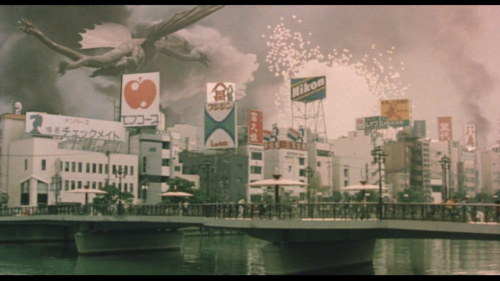
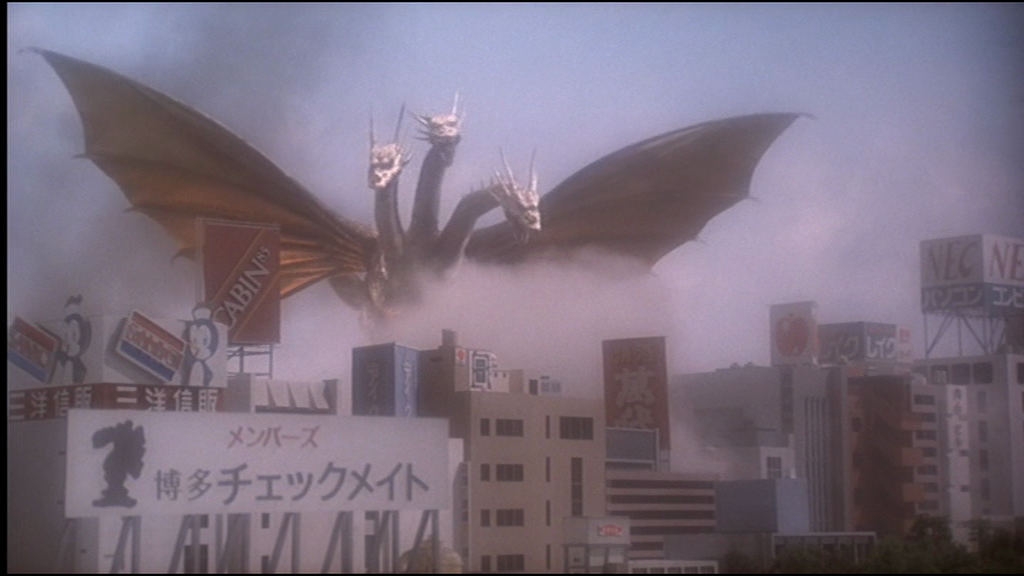

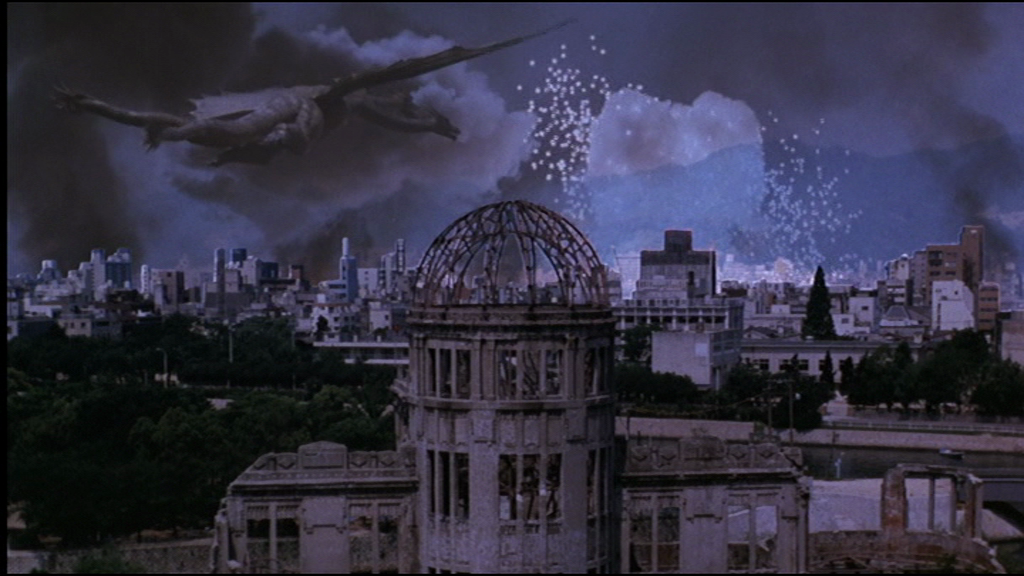
 The scene then transitions to a shot of the city of Kyushu, with Ghidorah eventually flying into the frame. It heads straight for a tower where Shindo is apparently having some sort of meeting and it smashes the window they're standing in front of as it flies over the tower, forcing them to take cover. Ghidorah then swings around and begins flying over the heart of the city, spreading its yellow lightning across it, blowing up building after building as hundreds of civilians run for shelter. An emergency radio announcement makes it known that Ghidorah isn't flying in any particular direction and that everyone must take immediate shelter. Ghidorah continues blowing up buildings as it slowly flies above the city, as the evacuation continues. It then lands in the middle of the city, destroying a building as it does so, and continues shooting its lightning in every direction, absolutely decimating everything in sight. After a lot of destruction, we get a brief shot of Emmy and Wilson as they watch the action on a holographic screen before we see Ghidorah blow two buildings to pieces before lifting off and leaving Kyushu, with a mildly injured Shindo cursing the monster for destroying all of prosperity he helped to build. After that, we get scenes of where our main characters realize that Ghidorah was intentionally created by the future people and Emmy realizing her comrades are going overboard in their plan to subjugate Japan when Wilson orders Ghidorah to be sent north to attack Hokkaido. After that, we get a short of Ghidorah doing so, destroying a bridge it flies over it, before going to the next human scene, where Emmy sneaks out of the ship and goes to Terasawa to tell him the truth about Japan in the 23rd century. We get more destruction by Ghidorah as it blows up an industrial complex before cutting to a scene with the government officials where they're sent another video text message from the future people, this time saying that they will use the computer to call Ghidorah off if the Japanese officials bow to their demands (yet another plothole: Wilson said that he intended to destroy all of Japan except Tokyo before giving them plans to rebuild the country but now they've gone to blackmail). Knowing that there's no way they can fight Ghidorah off with their armed forces, they try to figure out what to do, which leads to Dobashi suggesting that they could change the dinosaur in the Bering Sea into Godzilla with some radioactivity. As they debate about doing so, with Shindo offering to provide them with the nuclear submarine necessary to accomplish the task, we get our first real glimpse of Godzilla 55 minutes in when we see him slowly moving at the bottom of the sea. This leads into Miki's claim that she can sense Godzilla and their growing realization that he's being reborn due to a sunken nuclear submarine in the Bering Sea.
The scene then transitions to a shot of the city of Kyushu, with Ghidorah eventually flying into the frame. It heads straight for a tower where Shindo is apparently having some sort of meeting and it smashes the window they're standing in front of as it flies over the tower, forcing them to take cover. Ghidorah then swings around and begins flying over the heart of the city, spreading its yellow lightning across it, blowing up building after building as hundreds of civilians run for shelter. An emergency radio announcement makes it known that Ghidorah isn't flying in any particular direction and that everyone must take immediate shelter. Ghidorah continues blowing up buildings as it slowly flies above the city, as the evacuation continues. It then lands in the middle of the city, destroying a building as it does so, and continues shooting its lightning in every direction, absolutely decimating everything in sight. After a lot of destruction, we get a brief shot of Emmy and Wilson as they watch the action on a holographic screen before we see Ghidorah blow two buildings to pieces before lifting off and leaving Kyushu, with a mildly injured Shindo cursing the monster for destroying all of prosperity he helped to build. After that, we get scenes of where our main characters realize that Ghidorah was intentionally created by the future people and Emmy realizing her comrades are going overboard in their plan to subjugate Japan when Wilson orders Ghidorah to be sent north to attack Hokkaido. After that, we get a short of Ghidorah doing so, destroying a bridge it flies over it, before going to the next human scene, where Emmy sneaks out of the ship and goes to Terasawa to tell him the truth about Japan in the 23rd century. We get more destruction by Ghidorah as it blows up an industrial complex before cutting to a scene with the government officials where they're sent another video text message from the future people, this time saying that they will use the computer to call Ghidorah off if the Japanese officials bow to their demands (yet another plothole: Wilson said that he intended to destroy all of Japan except Tokyo before giving them plans to rebuild the country but now they've gone to blackmail). Knowing that there's no way they can fight Ghidorah off with their armed forces, they try to figure out what to do, which leads to Dobashi suggesting that they could change the dinosaur in the Bering Sea into Godzilla with some radioactivity. As they debate about doing so, with Shindo offering to provide them with the nuclear submarine necessary to accomplish the task, we get our first real glimpse of Godzilla 55 minutes in when we see him slowly moving at the bottom of the sea. This leads into Miki's claim that she can sense Godzilla and their growing realization that he's being reborn due to a sunken nuclear submarine in the Bering Sea. 

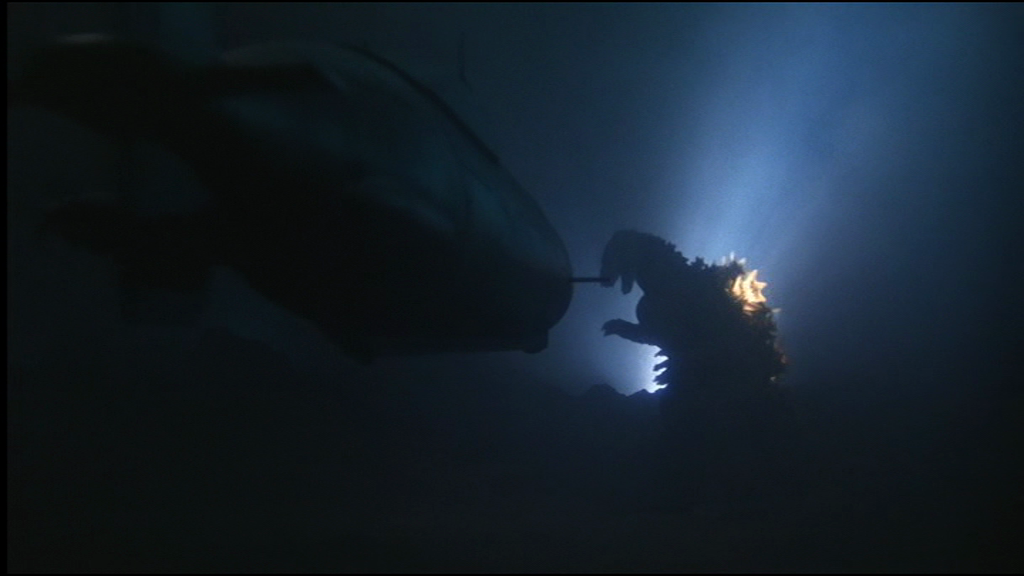

 Upon learning this, Terasawa heads out to go talk to Shindo in order to try to talk him into recalling the submarine and Emmy decides to go with him. However, as they head out in Terasawa's jeep, they're tailed by M-11 in a car. Once they get out on the road, the android speeds up to where he gets his car alongside them. Upon seeing him, Emmy warns Terasawa but before he can react, M-11 grabs ahold of the jeep's door and, after some pulling, and despite Emmy's attempts to shove him off, manages to tear it off. He then reaches in to pull Emmy out but she manages to fight him off by smacking him with her purse and kicking at him when he grabs ahold of her leg. Eventually, M-11 ducks back inside of his car when a truck carrying a bunch of boxes crosses the street right in front of them. Terasawa's jeep ends up going right through the boxes and landing on the street on the other (in the Japanese version, I swear Terasawa yells in a way that's like Tarzan), while M-11 tries to swerve around it but flips his car on its roof in the process, causing it to blow up and actually set one passerby's clothes on fire! M-11 gets up out of the burning car, now with some of his mechanical parts underneath showing through the burnt skin, and rips and takes off the burning suit jacket he's wearing. He begins running down the road at extreme and very easily catches up to Terasawa and Emmy, passes them, jumps out in front of them, and manages to bring the jeep to a complete stop with his jeep. He then grabs the underside of the jeep's front and lifts the whole thing up. Terasawa very foolishly contemplates getting out and fighting the android but Emmy stops him, knowing that M-11 has been ordered to take her back the spaceship, and she reluctantly gets out and goes with him. Upon returning to the ship, Emmy tells Wilson that the Japanese government plans to use anything they can to resist them (this dialogue is very different in the English dub) and he says that he thought it would come to this, stating that he knows that they would eventually think about turning the dinosaur in the Bering Sea into Godzilla. Speaking of which, we cut to Shindo's nuclear submarine, which is on its way to that very location, and after a quick scene where Emmy reprograms M-11 to help her, we go back to the submarine, which comes across the newly reborn Godzilla as he walks across the ocean floor. Before they even know what's going on, they slam right into Godzilla, with the submarine exploding in his hands as he grabs onto it. Shindo is immediately informed of what happened and he, in turn, informs Terasawa. The writer volunteers to head out to the Okhotsk Sea with Miki, per Shindo's wishes, but when he looks out the window and sees M-11, who motions for him to come with him, Terasawa tells Shindo that he can't go. After M-11 brings Terasawa to the ship, and Terasawa shows how not to operate a hover-pack when he flies up and bangs his head on the ceiling, Emmy shows him the computer her former comrades plan to give to the Japanese government. The next day, Miki and Prof. Mazaki are flown out to the Okhotsk Sea, where Godzilla finally enters the movie officially by emerging from the water with a roar. He watches the helicopter as it circles around before turning and heading back to the mainland, with Miki commenting that Godzilla's back with them again.
Upon learning this, Terasawa heads out to go talk to Shindo in order to try to talk him into recalling the submarine and Emmy decides to go with him. However, as they head out in Terasawa's jeep, they're tailed by M-11 in a car. Once they get out on the road, the android speeds up to where he gets his car alongside them. Upon seeing him, Emmy warns Terasawa but before he can react, M-11 grabs ahold of the jeep's door and, after some pulling, and despite Emmy's attempts to shove him off, manages to tear it off. He then reaches in to pull Emmy out but she manages to fight him off by smacking him with her purse and kicking at him when he grabs ahold of her leg. Eventually, M-11 ducks back inside of his car when a truck carrying a bunch of boxes crosses the street right in front of them. Terasawa's jeep ends up going right through the boxes and landing on the street on the other (in the Japanese version, I swear Terasawa yells in a way that's like Tarzan), while M-11 tries to swerve around it but flips his car on its roof in the process, causing it to blow up and actually set one passerby's clothes on fire! M-11 gets up out of the burning car, now with some of his mechanical parts underneath showing through the burnt skin, and rips and takes off the burning suit jacket he's wearing. He begins running down the road at extreme and very easily catches up to Terasawa and Emmy, passes them, jumps out in front of them, and manages to bring the jeep to a complete stop with his jeep. He then grabs the underside of the jeep's front and lifts the whole thing up. Terasawa very foolishly contemplates getting out and fighting the android but Emmy stops him, knowing that M-11 has been ordered to take her back the spaceship, and she reluctantly gets out and goes with him. Upon returning to the ship, Emmy tells Wilson that the Japanese government plans to use anything they can to resist them (this dialogue is very different in the English dub) and he says that he thought it would come to this, stating that he knows that they would eventually think about turning the dinosaur in the Bering Sea into Godzilla. Speaking of which, we cut to Shindo's nuclear submarine, which is on its way to that very location, and after a quick scene where Emmy reprograms M-11 to help her, we go back to the submarine, which comes across the newly reborn Godzilla as he walks across the ocean floor. Before they even know what's going on, they slam right into Godzilla, with the submarine exploding in his hands as he grabs onto it. Shindo is immediately informed of what happened and he, in turn, informs Terasawa. The writer volunteers to head out to the Okhotsk Sea with Miki, per Shindo's wishes, but when he looks out the window and sees M-11, who motions for him to come with him, Terasawa tells Shindo that he can't go. After M-11 brings Terasawa to the ship, and Terasawa shows how not to operate a hover-pack when he flies up and bangs his head on the ceiling, Emmy shows him the computer her former comrades plan to give to the Japanese government. The next day, Miki and Prof. Mazaki are flown out to the Okhotsk Sea, where Godzilla finally enters the movie officially by emerging from the water with a roar. He watches the helicopter as it circles around before turning and heading back to the mainland, with Miki commenting that Godzilla's back with them again. 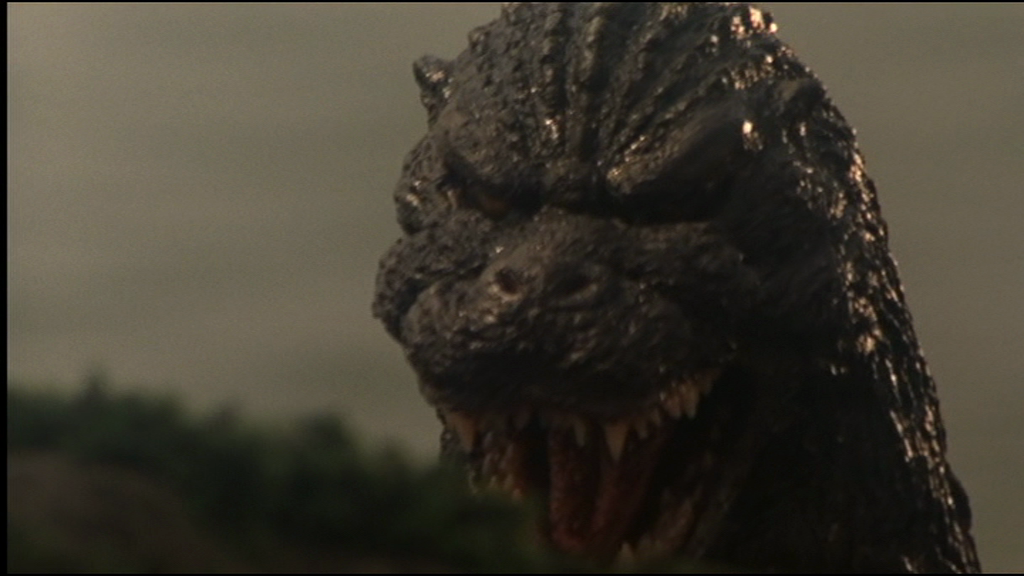
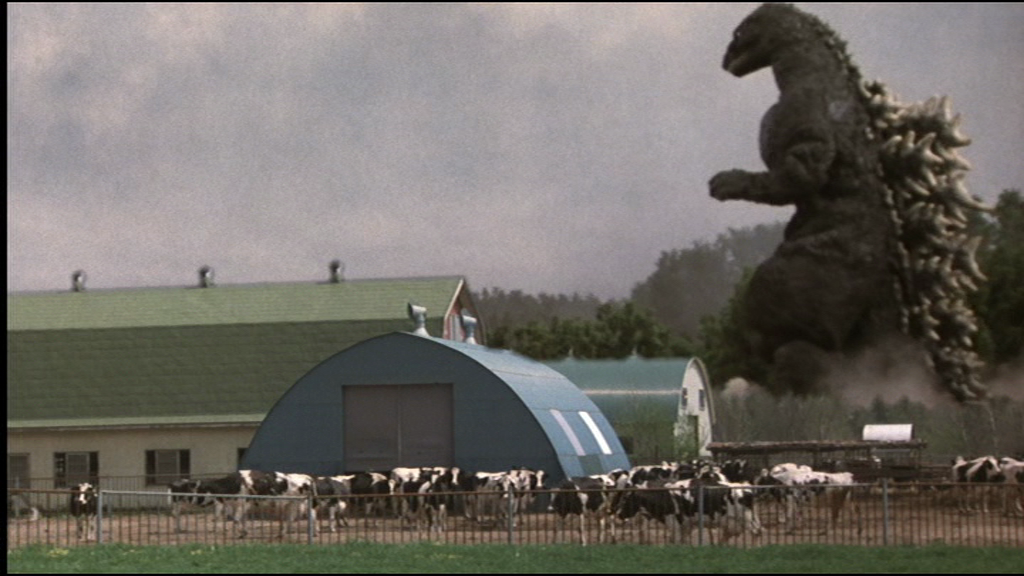
 While this is going on, a squadron of fighter jets intercepts and attacks King Ghidorah high up in the clouds. Two jets come up behind the dragon and fire some missiles on it but it doesn't react to this attack at all and when they very stupidly fly ahead of it, it chases after them. It blows up one jet with its lightning and then focuses on the other, which tries to disengage but Ghidorah manages to catch up to it and blow it up by smacking it with one of its tails as it zooms by. Four other fighter jets scramble, with one shooting Ghidorah from straight on but this only results in both it and one of its partners getting blown up by lightning bolts. The remaining jets are ordered to disengage but, as the scene switches to Wilson and Grenchiko watching the action on a holographic video screen, it seems as though the remaining ones got blown up as well. However, just when they're being smug about how easily the jets were destroyed by Ghidorah, Grenchiko notices an enormous blip approaching the northern coast of Hokkaido on a radar monitor of there's. We then cut to Godzilla, who wades through the shallows of the ocean near a lighthouse and comes ashore, roaring and growling and passing by a farm with cows before heading into the countryside, with Miki and Prof. Mazaki watching from a safe distance. Godzilla then walks right through some power lines without breaking his stride, as the government officials, who are watching this on their trusty video monitors in their control room, comment on how much bigger he apparently is. After Wilson and Grenchiko ponder about how Godzilla was destined to be created in this day and age and that their plan would have worked perfectly otherwise, Wilson orders for Ghidorah to be sent to battle Godzilla. Ghidorah immediately heads for Godzilla's location, passing over the spot where Miki and Mazaki currently are, before reaching Godzilla as he stomps into a vacant field. Godzilla stops when he sees Ghidorah flying towards him and when the dragon lands just a few feet away from him, the two of them begin roaring challenges at each other. At this time, Shindo is watching this confrontation on a video monitor in his office while looking at one of his old pictures of the Godzillasaur, lamenting that he will once again fight to save the Japanese. After the monsters square off and roar at each other a little more, Wilson orders for Ghidorah to attack.
While this is going on, a squadron of fighter jets intercepts and attacks King Ghidorah high up in the clouds. Two jets come up behind the dragon and fire some missiles on it but it doesn't react to this attack at all and when they very stupidly fly ahead of it, it chases after them. It blows up one jet with its lightning and then focuses on the other, which tries to disengage but Ghidorah manages to catch up to it and blow it up by smacking it with one of its tails as it zooms by. Four other fighter jets scramble, with one shooting Ghidorah from straight on but this only results in both it and one of its partners getting blown up by lightning bolts. The remaining jets are ordered to disengage but, as the scene switches to Wilson and Grenchiko watching the action on a holographic video screen, it seems as though the remaining ones got blown up as well. However, just when they're being smug about how easily the jets were destroyed by Ghidorah, Grenchiko notices an enormous blip approaching the northern coast of Hokkaido on a radar monitor of there's. We then cut to Godzilla, who wades through the shallows of the ocean near a lighthouse and comes ashore, roaring and growling and passing by a farm with cows before heading into the countryside, with Miki and Prof. Mazaki watching from a safe distance. Godzilla then walks right through some power lines without breaking his stride, as the government officials, who are watching this on their trusty video monitors in their control room, comment on how much bigger he apparently is. After Wilson and Grenchiko ponder about how Godzilla was destined to be created in this day and age and that their plan would have worked perfectly otherwise, Wilson orders for Ghidorah to be sent to battle Godzilla. Ghidorah immediately heads for Godzilla's location, passing over the spot where Miki and Mazaki currently are, before reaching Godzilla as he stomps into a vacant field. Godzilla stops when he sees Ghidorah flying towards him and when the dragon lands just a few feet away from him, the two of them begin roaring challenges at each other. At this time, Shindo is watching this confrontation on a video monitor in his office while looking at one of his old pictures of the Godzillasaur, lamenting that he will once again fight to save the Japanese. After the monsters square off and roar at each other a little more, Wilson orders for Ghidorah to attack. 

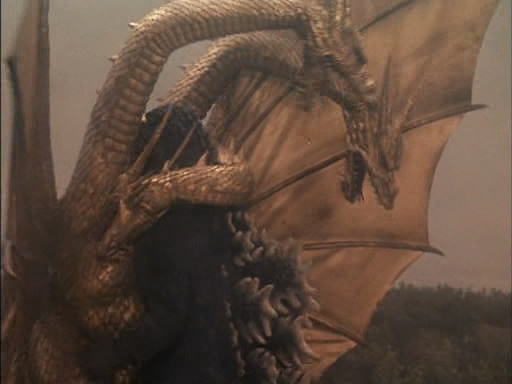
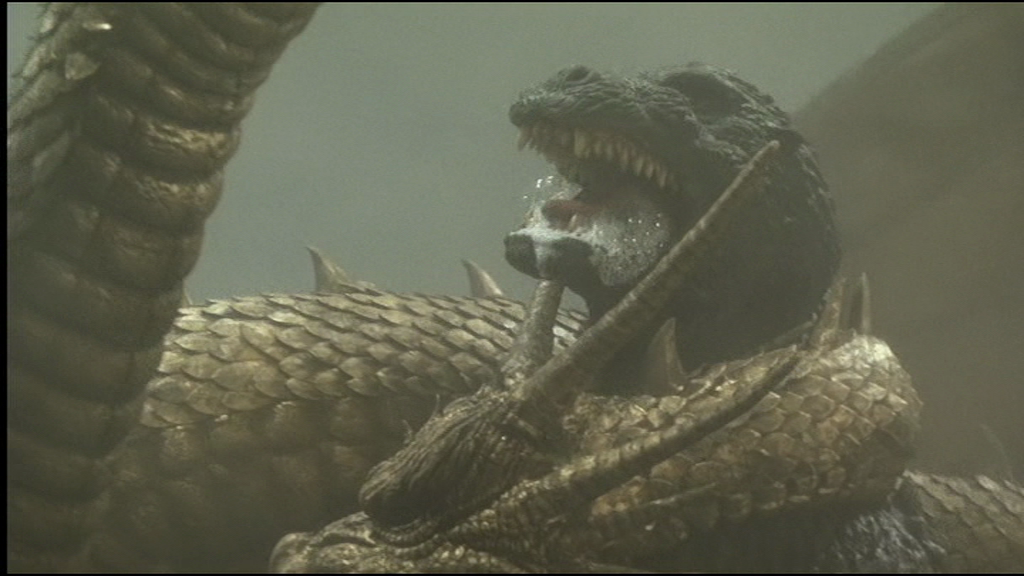

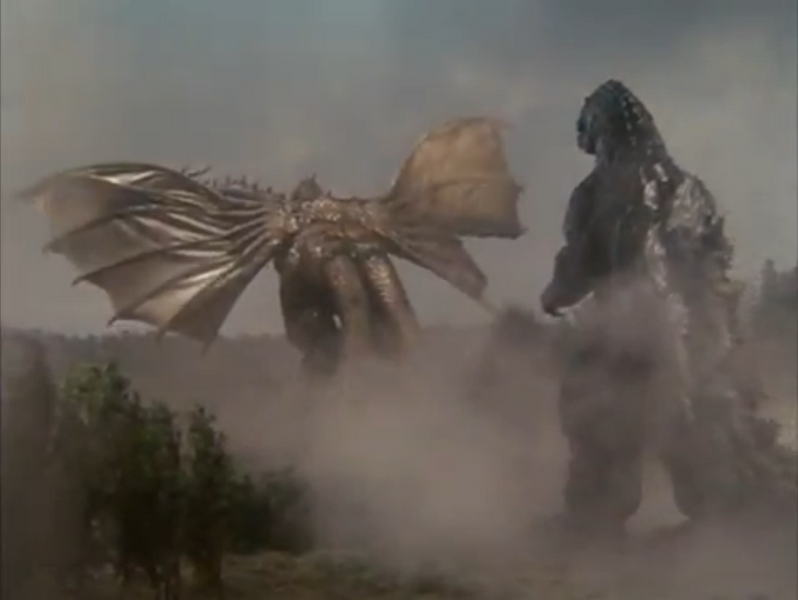 Back at the monster battle, Godzilla is still slamming Ghidorah up and down by its tails and then, he throws the dragon, causing it to crash on the ground and create a small cave-in itself. Godzilla stomps up behind Ghidorah in order to attack again but the dragon very quickly takes to the air and comes straight at him, virtually landing on top of him. It then holds his arms down with its left and right mouths, while the center neck comes and constricts his throat. Godzilla struggles to get free, clawing at Ghidorah's body as well as trying to shake himself loose, but it doesn't work. At the time machine, there are now only ten minutes left until the ship time warps back to the year 2204, and our three heroes race to the small, plane-like ship in order to escape. They take off from the hangar and come around to the front of the ship, with M-11 preparing the teleportation device in order to transport them to Godzilla's current location. Speaking of which, Godzilla is now foaming at the mouth and loudly groaning from his throat being constricted and, with no other way to escape, he attempts to fire his atomic blast, which causes a chain reaction within his body and creates a powerful pulse. Ghidorah is sent flying backwards from the force of the blast and, before it can get back up, Godzilla shoots his atomic blast directly at the base of the middle neck, blowing it completely off in an act of cruel vengeance. After badly maiming his enemy, Godzilla roars triumphantly. Back with our human heroes, M-11 very quickly initiates the teleportation sequence and fires the beam, sending the ship on a one-way ticket to the site of the monster battle. It reintegrates right next to Godzilla, immediately catching his attention. Inside the ship, Wilson and Grenchiko come to. Wilson thinks that they've time-warped but when the two of them see that there's still a minute left on the countdown, they wonder where they are. Wilson then opens up one of the shutters and they're greeted with Godzilla's sneering face as he looks directly at them. He opens fire on the ship, blowing it to smithereens and killing Wilson and Grenchiko instantly. Godzilla growls in satisfaction and then turns to see that the now two-headed Ghidorah is trying to fly off. Before it gets too far, Godzilla fires directly at its left wing, blowing a big hole in the membrane. Now unable to fly, Ghidorah drops out of the sky and splashes into the Okhotsk Sea, apparently dead. Godzilla roars in victory again before turning and leaving. However, the humans have no reason to celebrate the defeat of the future people because now, they once again have to contend with Godzilla himself.
Back at the monster battle, Godzilla is still slamming Ghidorah up and down by its tails and then, he throws the dragon, causing it to crash on the ground and create a small cave-in itself. Godzilla stomps up behind Ghidorah in order to attack again but the dragon very quickly takes to the air and comes straight at him, virtually landing on top of him. It then holds his arms down with its left and right mouths, while the center neck comes and constricts his throat. Godzilla struggles to get free, clawing at Ghidorah's body as well as trying to shake himself loose, but it doesn't work. At the time machine, there are now only ten minutes left until the ship time warps back to the year 2204, and our three heroes race to the small, plane-like ship in order to escape. They take off from the hangar and come around to the front of the ship, with M-11 preparing the teleportation device in order to transport them to Godzilla's current location. Speaking of which, Godzilla is now foaming at the mouth and loudly groaning from his throat being constricted and, with no other way to escape, he attempts to fire his atomic blast, which causes a chain reaction within his body and creates a powerful pulse. Ghidorah is sent flying backwards from the force of the blast and, before it can get back up, Godzilla shoots his atomic blast directly at the base of the middle neck, blowing it completely off in an act of cruel vengeance. After badly maiming his enemy, Godzilla roars triumphantly. Back with our human heroes, M-11 very quickly initiates the teleportation sequence and fires the beam, sending the ship on a one-way ticket to the site of the monster battle. It reintegrates right next to Godzilla, immediately catching his attention. Inside the ship, Wilson and Grenchiko come to. Wilson thinks that they've time-warped but when the two of them see that there's still a minute left on the countdown, they wonder where they are. Wilson then opens up one of the shutters and they're greeted with Godzilla's sneering face as he looks directly at them. He opens fire on the ship, blowing it to smithereens and killing Wilson and Grenchiko instantly. Godzilla growls in satisfaction and then turns to see that the now two-headed Ghidorah is trying to fly off. Before it gets too far, Godzilla fires directly at its left wing, blowing a big hole in the membrane. Now unable to fly, Ghidorah drops out of the sky and splashes into the Okhotsk Sea, apparently dead. Godzilla roars in victory again before turning and leaving. However, the humans have no reason to celebrate the defeat of the future people because now, they once again have to contend with Godzilla himself. 
 After M-11 and Emmy give Fujio and Terasawa the grim news that there's a 91% chance that Godzilla will attack Tokyo, Miki and Prof. Mazaki burst in to tell them that Godzilla has appeared in Sapporo. Cutting to that very city, an evacuation is already underway and the military is being moved in. Godzilla plows through a building that comes up to his waist, prompting dozens of civilians to head into an underground shelter. Godzilla approaches the enormous tower in the middle of Sapporo, causing massive explosions behind him as he moves, while the military up positions in the street leading up to the tower. A couple of high-tech maser cannons fire at him, zapping his torso and sending sparks flying in the process, but they're unable to prevent Godzilla from toppling the tower over, which smashes into a building across from it. As Godzilla continues down the street, the maser cannons back up while continuing to fire at him. Shrugging off those blasts, Godzilla keeps walking when his foot suddenly goes right through the pavement and crashes into an underground shelter. He loses his balance and falls over, going right through the concrete and bashing his head against the edge of the pit (which gave Kenpachiro Satsuma a concussion, I might add), as those who were taking shelter try to keep from getting crushed. Feeling that now's their chance while he's momentarily incapacitated, the maser cannons pull up behind Godzilla, as he tries to work himself out of the hole in the street, and blast the back and side of his head. Godzilla, however, manages to get back up, with his tail smashing through a building as he does so, and as he turns around and faces the still-firing masers, he unleashes his fury, first blasting some buildings on the side before turning on the military vehicles. He fries some soldiers and their tanks (which I didn't even know were there until just then) and then, completely decimates the maser cannons, blowing them up along with the entire blocks that they're parked on. The government officials, as usual, are watching everything on the video monitor in the control room and realize that it's hopeless, that there's no way they can defeat Godzilla. Meanwhile, Terasawa comes up with an idea to raise King Ghidorah from the ocean in order to get it to fight Godzilla (it's like a never-ending cycle, isn't it?) Emmy decides to go back to the 23rd century to salvage it, turn it into a cyborg, and bring it back to 1992. After she leaves, we cut back to where we started, with the advanced submarine in the Sea of Okhotsk in 2204, and learn that Emmy and M-11 are onboard the sub. After finding King Ghidorah's body and learning that it's heart is still beating, Emmy asks the man with her to salvage it so she can turn it into a cyborg. At first, he isn't to thrilled to allow her to go back and help Japan, feeling that the country deserved to be destroyed by Godzilla after so many years of vain prosperity but when she pleads with him, he relents and allows her to do it.
After M-11 and Emmy give Fujio and Terasawa the grim news that there's a 91% chance that Godzilla will attack Tokyo, Miki and Prof. Mazaki burst in to tell them that Godzilla has appeared in Sapporo. Cutting to that very city, an evacuation is already underway and the military is being moved in. Godzilla plows through a building that comes up to his waist, prompting dozens of civilians to head into an underground shelter. Godzilla approaches the enormous tower in the middle of Sapporo, causing massive explosions behind him as he moves, while the military up positions in the street leading up to the tower. A couple of high-tech maser cannons fire at him, zapping his torso and sending sparks flying in the process, but they're unable to prevent Godzilla from toppling the tower over, which smashes into a building across from it. As Godzilla continues down the street, the maser cannons back up while continuing to fire at him. Shrugging off those blasts, Godzilla keeps walking when his foot suddenly goes right through the pavement and crashes into an underground shelter. He loses his balance and falls over, going right through the concrete and bashing his head against the edge of the pit (which gave Kenpachiro Satsuma a concussion, I might add), as those who were taking shelter try to keep from getting crushed. Feeling that now's their chance while he's momentarily incapacitated, the maser cannons pull up behind Godzilla, as he tries to work himself out of the hole in the street, and blast the back and side of his head. Godzilla, however, manages to get back up, with his tail smashing through a building as he does so, and as he turns around and faces the still-firing masers, he unleashes his fury, first blasting some buildings on the side before turning on the military vehicles. He fries some soldiers and their tanks (which I didn't even know were there until just then) and then, completely decimates the maser cannons, blowing them up along with the entire blocks that they're parked on. The government officials, as usual, are watching everything on the video monitor in the control room and realize that it's hopeless, that there's no way they can defeat Godzilla. Meanwhile, Terasawa comes up with an idea to raise King Ghidorah from the ocean in order to get it to fight Godzilla (it's like a never-ending cycle, isn't it?) Emmy decides to go back to the 23rd century to salvage it, turn it into a cyborg, and bring it back to 1992. After she leaves, we cut back to where we started, with the advanced submarine in the Sea of Okhotsk in 2204, and learn that Emmy and M-11 are onboard the sub. After finding King Ghidorah's body and learning that it's heart is still beating, Emmy asks the man with her to salvage it so she can turn it into a cyborg. At first, he isn't to thrilled to allow her to go back and help Japan, feeling that the country deserved to be destroyed by Godzilla after so many years of vain prosperity but when she pleads with him, he relents and allows her to do it. 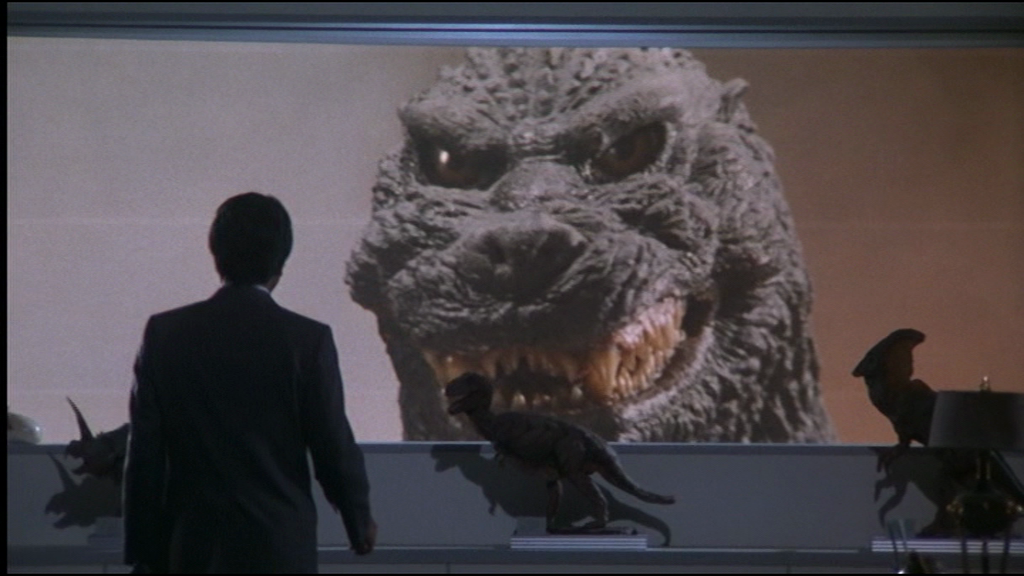
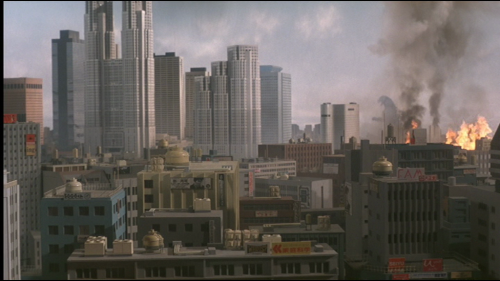


 Back in 1992, Tokyo has been evacuated due to Godzilla's advance on the city, but two reporters, one of whom calls himself Japan's Peter Arnett, manage to sneak past the military blockade and make it back into the heart of the city to cover the action. In the control room, the officials are informed that the evacuation is complete and they talk about how Tokyo's sacrifice is a necessary one but, upon Godzilla stomping through the city and destroying everything, Dobashi comments on how this will ruin Japan's future. He's then told that there's a call for him and when he answers it, he's shocked to find out that it's Shindo, who's still in his office in Shinjuku. Dobashi warns him that he has to get out because Godzilla is heading his way. However, Shindo says that this is how he wants it to be and laments about how the very dinosaur that saved him and his garrison, allowing him to return home and eventually strengthen his country's prosperity, is destroying that same prosperity at the very moment. After telling Dobashi that the whole thing is very ironic, Shindo hangs up and, as Godzilla passes in front of his building, he walks up to the window and comes face-to-face with his former savior. Godzilla turns and looks at him and, as tears well up in Shindo's eyes, lets a loud, threatening roar, proving that he's no longer the dinosaur that saved his life. However, as Shindo remembers back to the injured Godzillasaur, Godzilla himself remembers who Shindo was and, as tears begin welling up in his eyes, he's clearly touched by those memories, almost as if he's cherishing them. After Shindo nods to him, Godzilla lets out a roar and, for whatever reason you want to give, blasts him head on, killing him instantly, before demolishing the rest of the building himself. Fujio and the others are then informed of Shindo's death and, as they watch Godzilla as he continues to attack Tokyo, Terasawa wonders why Emmy hasn't shown up yet, with Miki herself wondering if it was impossible to bring King Ghidorah back to life. Back outside, Godzilla heads into the center of the Shinjuku District, wreaking havoc as he goes, smashing up a smaller building, crushing a street and causing it to take cave in with his foot, walking right through an enclosed bridge, and smashing his feet through the windows of an abandoned convention center. Before he can continue his rampage, Godzilla is distracted by a hissing sound and as he looks up into the sky, he sees Mecha-King Ghidorah materialize from the time warp. As Terasawa and the others rejoice in Emmy's return, Godzilla tries to blast the cyborg Ghidorah as it flies around Shinjuku but only manages to blow up the tops of some buildings. He then watches as it continues circling the district and lands in an open area not too far from where he's currently standing amongst the district's enormous buildings. After getting everything set up from inside the cyborg's control module, Emmy and M-11, the latter of whom is serving as the computer since his discs are programmed into it, prepare for battle.
Back in 1992, Tokyo has been evacuated due to Godzilla's advance on the city, but two reporters, one of whom calls himself Japan's Peter Arnett, manage to sneak past the military blockade and make it back into the heart of the city to cover the action. In the control room, the officials are informed that the evacuation is complete and they talk about how Tokyo's sacrifice is a necessary one but, upon Godzilla stomping through the city and destroying everything, Dobashi comments on how this will ruin Japan's future. He's then told that there's a call for him and when he answers it, he's shocked to find out that it's Shindo, who's still in his office in Shinjuku. Dobashi warns him that he has to get out because Godzilla is heading his way. However, Shindo says that this is how he wants it to be and laments about how the very dinosaur that saved him and his garrison, allowing him to return home and eventually strengthen his country's prosperity, is destroying that same prosperity at the very moment. After telling Dobashi that the whole thing is very ironic, Shindo hangs up and, as Godzilla passes in front of his building, he walks up to the window and comes face-to-face with his former savior. Godzilla turns and looks at him and, as tears well up in Shindo's eyes, lets a loud, threatening roar, proving that he's no longer the dinosaur that saved his life. However, as Shindo remembers back to the injured Godzillasaur, Godzilla himself remembers who Shindo was and, as tears begin welling up in his eyes, he's clearly touched by those memories, almost as if he's cherishing them. After Shindo nods to him, Godzilla lets out a roar and, for whatever reason you want to give, blasts him head on, killing him instantly, before demolishing the rest of the building himself. Fujio and the others are then informed of Shindo's death and, as they watch Godzilla as he continues to attack Tokyo, Terasawa wonders why Emmy hasn't shown up yet, with Miki herself wondering if it was impossible to bring King Ghidorah back to life. Back outside, Godzilla heads into the center of the Shinjuku District, wreaking havoc as he goes, smashing up a smaller building, crushing a street and causing it to take cave in with his foot, walking right through an enclosed bridge, and smashing his feet through the windows of an abandoned convention center. Before he can continue his rampage, Godzilla is distracted by a hissing sound and as he looks up into the sky, he sees Mecha-King Ghidorah materialize from the time warp. As Terasawa and the others rejoice in Emmy's return, Godzilla tries to blast the cyborg Ghidorah as it flies around Shinjuku but only manages to blow up the tops of some buildings. He then watches as it continues circling the district and lands in an open area not too far from where he's currently standing amongst the district's enormous buildings. After getting everything set up from inside the cyborg's control module, Emmy and M-11, the latter of whom is serving as the computer since his discs are programmed into it, prepare for battle. 


 Emmy fires Mecha-King Ghidorah's plasma ray and lightning bolts directly at Godzilla, creating a bunch of explosions on his body and around him, causing great damage the buildings he's in-between. After taking the brunt of these blasts, Godzilla fires back twice in a row, the second time taking off the side of a building, hitting the cyborg in the chest plate both times and causing Emmy to scream as the control module is shaken from the battle. Godzilla pushes what's left of that one building out of his way as he heads towards Mecha-King Ghidorah, who unleashes all three of its rays on him at once again. After getting zapped head on again and again, Godzilla shoots his atomic blast but apparently missed completely this time. After a shot where we see some nearby troops taking cover from the battle, we see Godzilla get blasted many, many more times, forcing him back in the midst of the buildings. Godzilla stumbles backwards and eventually loses his balance, falling against the front of one building (which those reporters we saw earlier happen to be in) and, before he can get back up, Mecha-King Ghidorah around the top of it, burying Godzilla under a ton of concrete and steel rubble. Emmy then moves the cyborg towards the rubble in order to finish him off but, without warning, Godzilla's atomic blast comes shooting out from beneath it and hits the base of Mecha-King Ghidorah's cybernetic middle neck. Following it up with another blast, Godzilla explodes out from under the rubble and heads straight for the cyborg. Frantically messing about with the control, Emmy attempts to take to the air but Godzilla runs up to Mecha-King Ghidorah and grabs its legs. While holding onto the cyborg, Godzilla directs an atomic blast at the center of its right wing, which Emmy responds with by having it drive him backwards into another building. However, despite this, Godzilla keeps his hold on Mecha-King Ghidorah, even when he bends down towards the ground. The left head comes around and bites Godzilla's neck, trying to make him let go, but Godzilla retaliates by shooting the right wing again. Mecha-King Ghidorah finally pries itself loose from Godzilla's grip but, when Emmy attempts to take to the air again, Godzilla fires on the cyborg, this time hitting the left wing and crippling its ability to fly. Mecha-King Ghidorah comes crashing down to the ground on its back, the impact of which tosses Emmy around the inside of the control module until she's knocked unconscious. Never one to show any mercy, Godzilla slowly walks toward the now helpless cyborg, closing in for the kill. Inside the control module, M-11 manages to wake Emmy up and tells her to activate the Godzilla Grip program.
Emmy fires Mecha-King Ghidorah's plasma ray and lightning bolts directly at Godzilla, creating a bunch of explosions on his body and around him, causing great damage the buildings he's in-between. After taking the brunt of these blasts, Godzilla fires back twice in a row, the second time taking off the side of a building, hitting the cyborg in the chest plate both times and causing Emmy to scream as the control module is shaken from the battle. Godzilla pushes what's left of that one building out of his way as he heads towards Mecha-King Ghidorah, who unleashes all three of its rays on him at once again. After getting zapped head on again and again, Godzilla shoots his atomic blast but apparently missed completely this time. After a shot where we see some nearby troops taking cover from the battle, we see Godzilla get blasted many, many more times, forcing him back in the midst of the buildings. Godzilla stumbles backwards and eventually loses his balance, falling against the front of one building (which those reporters we saw earlier happen to be in) and, before he can get back up, Mecha-King Ghidorah around the top of it, burying Godzilla under a ton of concrete and steel rubble. Emmy then moves the cyborg towards the rubble in order to finish him off but, without warning, Godzilla's atomic blast comes shooting out from beneath it and hits the base of Mecha-King Ghidorah's cybernetic middle neck. Following it up with another blast, Godzilla explodes out from under the rubble and heads straight for the cyborg. Frantically messing about with the control, Emmy attempts to take to the air but Godzilla runs up to Mecha-King Ghidorah and grabs its legs. While holding onto the cyborg, Godzilla directs an atomic blast at the center of its right wing, which Emmy responds with by having it drive him backwards into another building. However, despite this, Godzilla keeps his hold on Mecha-King Ghidorah, even when he bends down towards the ground. The left head comes around and bites Godzilla's neck, trying to make him let go, but Godzilla retaliates by shooting the right wing again. Mecha-King Ghidorah finally pries itself loose from Godzilla's grip but, when Emmy attempts to take to the air again, Godzilla fires on the cyborg, this time hitting the left wing and crippling its ability to fly. Mecha-King Ghidorah comes crashing down to the ground on its back, the impact of which tosses Emmy around the inside of the control module until she's knocked unconscious. Never one to show any mercy, Godzilla slowly walks toward the now helpless cyborg, closing in for the kill. Inside the control module, M-11 manages to wake Emmy up and tells her to activate the Godzilla Grip program. 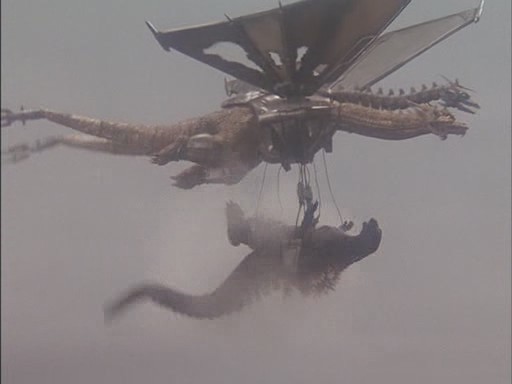

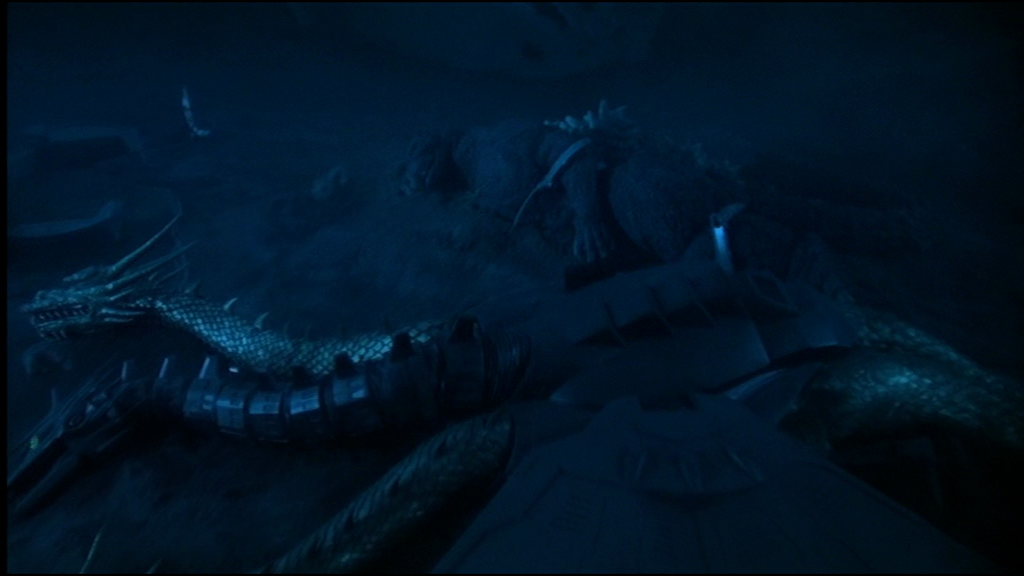
 Just when Godzilla is almost on top of Mecha-King Ghidorah, Emmy throws the switch, which gets the cyborg upright again and, before Godzilla can react, four energy-conducting cables with grips on them shoot out of its chest place and grab onto Godzilla's arms and legs. As energy is sent through the cables to Godzilla's body in order to weaken him, Emmy activates the enormous machine hand, which shoots out and grabs onto Godzilla's stomach, completely immobilizing him as it electrocutes him even more. With Godzilla secured, Mecha-King Ghidorah takes to the air, pulling Godzilla along with it until he's being held completely upside down. Both of them leave the city but, before they can get too far, M-11 warns Emmy that they won't be able to withstand another direct hit from the atomic blast again. Knowing what she has to do, Emmy transports Godzilla just a little further out to sea where, after failing to get himself loose with brute strength, he blasts the cyborg's chest plate again, this time completely crippling its circuits and causing both of them to plummet into the water below. Everyone watches anxiously, concerned for Emmy's safety, but they're relieved when the smaller time machine comes out of the water completely unscathed. Emmy and M-11 prepare to depart for the 23rd century but, before they go, Emmy reveals that Terasawa is a distant relative of hers. Once they've departed, it seems like everything's fine and dandy... until we get a shot of the bottom of the ocean where Godzilla lies alongside Mecha-King Ghidorah. Suddenly, sparks run along Godzilla's head and his eyes open, glowing blue, as do his dorsal plates, and he sits up and fires his atomic blast through the water, having survived to menace the world again someday. However, I have to say that I don't like the ending credits of the Japanese version, which scroll over an image of Godzilla's writhing and twisting beneath the water for a good two or so minutes. It's just awkward and isn't at all impactful or... whatever it was they were hoping it would be. You'd think they would have filmed him getting up and swimming away or something more dramatic than this.
Just when Godzilla is almost on top of Mecha-King Ghidorah, Emmy throws the switch, which gets the cyborg upright again and, before Godzilla can react, four energy-conducting cables with grips on them shoot out of its chest place and grab onto Godzilla's arms and legs. As energy is sent through the cables to Godzilla's body in order to weaken him, Emmy activates the enormous machine hand, which shoots out and grabs onto Godzilla's stomach, completely immobilizing him as it electrocutes him even more. With Godzilla secured, Mecha-King Ghidorah takes to the air, pulling Godzilla along with it until he's being held completely upside down. Both of them leave the city but, before they can get too far, M-11 warns Emmy that they won't be able to withstand another direct hit from the atomic blast again. Knowing what she has to do, Emmy transports Godzilla just a little further out to sea where, after failing to get himself loose with brute strength, he blasts the cyborg's chest plate again, this time completely crippling its circuits and causing both of them to plummet into the water below. Everyone watches anxiously, concerned for Emmy's safety, but they're relieved when the smaller time machine comes out of the water completely unscathed. Emmy and M-11 prepare to depart for the 23rd century but, before they go, Emmy reveals that Terasawa is a distant relative of hers. Once they've departed, it seems like everything's fine and dandy... until we get a shot of the bottom of the ocean where Godzilla lies alongside Mecha-King Ghidorah. Suddenly, sparks run along Godzilla's head and his eyes open, glowing blue, as do his dorsal plates, and he sits up and fires his atomic blast through the water, having survived to menace the world again someday. However, I have to say that I don't like the ending credits of the Japanese version, which scroll over an image of Godzilla's writhing and twisting beneath the water for a good two or so minutes. It's just awkward and isn't at all impactful or... whatever it was they were hoping it would be. You'd think they would have filmed him getting up and swimming away or something more dramatic than this.After having been absent from the first two films of this second cycle of Godzilla, as well as having not done an actual film score since 1978 unless you count his 1984 symphony Godzilla Fantasia, Akira Ifukube was finally lured back and, except for Godzilla vs. SpaceGodzilla, would compose the music for the rest of the Heisei series. After the rather lackluster score of Godzilla vs. Biollante, his return is very much welcomed and, not surprisingly, the music he created for Godzilla vs. King Ghidorah is one of the film's best aspects. Of course, you get Godzilla's theme, as you did in the previous film, which is composed in both a very slow, plodding, and powerful way with just the familiar, "Dun, dun-dun-dun-dun, dun-dun-dun,", and in a way that's a little bit faster, that has an extra "dun" put into the beginning, and leads into the march he originally composed for the military in the original Godzilla. You also get an awesome reprise of King Ghidorah's distinctive theme from the original series, now orchestrated to sound much bigger and more powerful. What's more, when Ghidorah is released from the control of the people from the future, Ifukube plays its theme but slows it down very considerably, as if to emphasize that now, the dragon isn't as unbeatable as it was before. Ifukube also comes up with some other memorable, most notably when dealing with the people from the future and with what Godzilla was before he was mutated by the atomic bomb. The music involving the people from the future is noticeably much more modern and mechanical in the way it sounds, with a prominent sound like that of an electronic keyboard in one bit of music that you hear when Emmy and Terasawa race to the control of the time machine as it shorts out around them. M-11 has a distinct theme that you first hear very softly and eerily when Terasawa, Miki Saegusa, and Prof. Mazaki, along with Fujio and Dobashi, enter the time machine and are taken up into it, and it becomes faster and is accompanied by a driving, percussive sound later on when the android shows what he can really do. There's also a really frantic, mechanical-sounding theme that hear when the time machine first appears at the beginning of the movie and later on when Ghidorah attacks Kyushu as well as popping up in various action sequences. And speaking of Ghidorah, when the Dorats are first introduced, if you listen closely to the music, you will notice that it's a very soft, subtle version of Ghidorah's theme, implying what's to come. As for the stuff involving the Godzillasaur, Ifukube does some interesting reprisals with these themes as the story progresses. The loud and bombastic horn music that you hear when the Godzillasaur first appears in the 1944 section of the film is actually heard in a softer and subtler form earlier on in the film when the subject of him is brought up when Terasawa is trying to get information on him and it's played again when Godzilla attacks Sapporo. Not only does it come across as powerful but there's also a sadness to it, indicating both what happens to him when he gets caught up in the battle between the Americans and the Japanese on Lagos Island and what he's become when he's decimating Sapporo. A very sad bit of music called Farewell to the Dinosaur is first played when the Japanese troops are forced to leave the injured Godzillasaur behind and Shindo thanks him for saving their lives. The implication of its name is obvious there but, when it's played again later on when Shindo and Godzilla come face-to-face in Tokyo, the implication is even sadder as Shindo sees that he's no longer the dinosaur that saved his life and Godzilla sends the man off himself by blasting him head on. And finally, as he often did in the past, Ifukube proves he's capable of writing good music for the military, like the stuff we hear during the Japanese troops' charge on Lagos Island and the air force attack on Ghidorah, and softer, quieter moments like the one between Terasawa and Emmy when she tells him of Japan's actual future. Needless to say, it's great to have Mr. Ifukube back and he'll only continue to give us more good scores as the Heisei series goes on.
 Due to the pitiful state of the Cannes Film market, and the international film industry in general, at the time, as well as the controversy that the film's content ended up creating in America when it was reported in the media, Toho was unable to find any American distributor for Godzilla vs. King Ghidorah whatsoever and so, in the coming years, they wouldn't even bother. This and the next film, Godzilla and Mothra: The Battle for Earth, wouldn't get an American video release until 1998 to coincide with the release of the TriStar Godzilla movie, with the rest of the entries in the Heisei series coming out the following year. Sony, which put all of these movies out over here, simply followed what had been the norm for a long time and used the Hong Kong-produced, international dubs, although they cut out the Toho logo that the films began with and simply put in white credits over a black background that said, TriStar Pictures Presents, A Toho Co., Production. Besides replacing the Japanese opening credits with English ones, they also cut the ending credits short and had the films simply fade to black, with the copyright information scrolling up, ending them that way. I have various opinions on this latter practice that depend on the particular film but, after I saw the awkward ending credits with Godzilla's head just twisting and turning for two minutes underwater, I think they made the right decision in cutting that. I also have various opinions on the English dubs for each film. For Godzilla vs. King Ghidorah, I think the English dub worked in that it gave the English-speaking actors from the Japanese version better-sounding voices. Nothing could have made that, "Take that, you dinosaur," line or that Maj. Spielberg joke better but, at least the really bad performances of those actors are fixed somewhat, with the same going for M-11. Most of the voices for the other characters are okay, although there doesn't appear to have been a lot of people hired to do these dubs since you hear the same voices over and over again from movie to movie, sometimes dubbing two or three characters in a given film. Also, I really don't like the voice they gave Miki Saegusa here. It's far too shrill and childish. I also don't like the voice for Grenchiko. The guy who did him was trying way too hard and it comes across as amateurish. Plus, he also does the voice for the guy who warns the people of Kyushu when Ghidorah is attacking it that they must evacuate, never changing his voice at all, which really confused me when I was a little kid because I didn't get why Grenchiko was telling people to take shelter and such. I like his line, "Do not drive in your car when King Ghidorah is in your area!"
Due to the pitiful state of the Cannes Film market, and the international film industry in general, at the time, as well as the controversy that the film's content ended up creating in America when it was reported in the media, Toho was unable to find any American distributor for Godzilla vs. King Ghidorah whatsoever and so, in the coming years, they wouldn't even bother. This and the next film, Godzilla and Mothra: The Battle for Earth, wouldn't get an American video release until 1998 to coincide with the release of the TriStar Godzilla movie, with the rest of the entries in the Heisei series coming out the following year. Sony, which put all of these movies out over here, simply followed what had been the norm for a long time and used the Hong Kong-produced, international dubs, although they cut out the Toho logo that the films began with and simply put in white credits over a black background that said, TriStar Pictures Presents, A Toho Co., Production. Besides replacing the Japanese opening credits with English ones, they also cut the ending credits short and had the films simply fade to black, with the copyright information scrolling up, ending them that way. I have various opinions on this latter practice that depend on the particular film but, after I saw the awkward ending credits with Godzilla's head just twisting and turning for two minutes underwater, I think they made the right decision in cutting that. I also have various opinions on the English dubs for each film. For Godzilla vs. King Ghidorah, I think the English dub worked in that it gave the English-speaking actors from the Japanese version better-sounding voices. Nothing could have made that, "Take that, you dinosaur," line or that Maj. Spielberg joke better but, at least the really bad performances of those actors are fixed somewhat, with the same going for M-11. Most of the voices for the other characters are okay, although there doesn't appear to have been a lot of people hired to do these dubs since you hear the same voices over and over again from movie to movie, sometimes dubbing two or three characters in a given film. Also, I really don't like the voice they gave Miki Saegusa here. It's far too shrill and childish. I also don't like the voice for Grenchiko. The guy who did him was trying way too hard and it comes across as amateurish. Plus, he also does the voice for the guy who warns the people of Kyushu when Ghidorah is attacking it that they must evacuate, never changing his voice at all, which really confused me when I was a little kid because I didn't get why Grenchiko was telling people to take shelter and such. I like his line, "Do not drive in your car when King Ghidorah is in your area!" Another thing that I find weird is how they changed the dialogue for the English dubbing. That happens all the time, sure, but the thing is that here, the very meaning of some of the dialogue is changed. The most notable change I can think of is when Emmy is brought back to the ship by M-11 and talks with Wilson and Grenchiko. In the Japanese version, Wilson asks Emmy what the Japanese government plans to use to resist them and she says, "Anything," adding that they won't lay down for them just because they're from the future. In the English dub, Wilson simply asks if the Japanese government is going to resist them at all, with Emmy responding, "Of course not. The Japanese government's not stupid. They know they can't fight us with our advanced weapons." Quite a difference, wouldn't you agree? Plus, when Wilson and Grenchiko are talking about how Godzilla has been reborn, in the English dub, Grenchiko says a line I've never liked: "The second birth of Godzilla was an unavoidable event." It just sounds bad to me. The line in the Japanese version, where he says, "Godzilla's birth was inevitable," is much better. Another notable change is in the scene when Prof. Mazaki is looking at Shindo's old photographs of the Godzillasaur. In the Japanese version, Mazaki notes how the dinosaur's head is smaller than that of a Tyrannosaurus Rex, with Terasawa commenting that the effect of the H-Bomb probably changed the face and the limbs. In the English dub, Mazaki says that Godzilla's head is smaller than that of a Tyrannosaurus and Terasawa tells him to simply look closely at the face and limbs of the dinosaur in the picture. Again, it's awkward and doesn't fit. Godzilla's head smaller than that of a normal dinosaur? Please. Finally, in order to show you the flipside of things, let's talk about some dialogue that occurs in the scene early in the film where Miki pulls up the path of the UFO on a video screen to show the government officials. In the Japanese version, she says that the image you see in the ocean is the small island where Godzilla fought Biollante but if you watch the previous film, you'd know that they fought in the mountains near Osaka on the mainland of Japan. In the English dub, she says that image is Godzilla himself after he was driven there by Biollante, making a little more sense. But then, they have to mess it up in the English dub by saying that the Anti-Nuclear Energy Bacteria has kept him alive, whereas in the Japanese version, Miki says that he's still weak from its effects. So, as you can see, you have to pick your poison when it comes to the two versions of this film. Personally, I'd go with the Japanese version, since it has less errors in the dialogue as well as just some plain better lines.
 Make no mistake about it, Godzilla vs. King Ghidorah is one rough little jewel of a film. The dialogue in both versions of the film is sometimes a bit confusing, there are plotholes galore, especially when it comes to the time-travel aspect of it, with those errors not only flying in the face of what has been established before but continuing to cause problems throughout the Heisei series' run, Kazuki Omori proves his weakness as a writer even further by outright copying the elements of Hollywood blockbusters like Back to the Future and The Terminator, and some of the effects work is a step down from and, in some cases, laughable when compared to the almost flawless stuff in Godzilla vs. Biollante. But, that said, this film as a bigger sense of fun and wonder than the previous one did, a good chunk of the effects work is still really good, especially the stuff concerning the monsters, Godzilla and both versions of King Ghidorah look awesome, the monster battles and action scenes involving the human characters are pretty entertaining, and the issues that the film brings up about Japan's quickly-growing economy at the time and the tension that was causing are interesting and worth talking about. Basically what I'm saying is that when you go into this film, you have to restrain yourself from nitpicking it to death because if you do, you will come out absolutely hating it, thinking it's one of the worst Godzilla movies ever. If you simply can't keep yourself from overanalyzing the most minute detail, you'd best steer clear of this one. For those who can, though, I think you'll find that there's an entertaining Godzilla flick with some important things to say underneath all of the errors and plotholes.
Make no mistake about it, Godzilla vs. King Ghidorah is one rough little jewel of a film. The dialogue in both versions of the film is sometimes a bit confusing, there are plotholes galore, especially when it comes to the time-travel aspect of it, with those errors not only flying in the face of what has been established before but continuing to cause problems throughout the Heisei series' run, Kazuki Omori proves his weakness as a writer even further by outright copying the elements of Hollywood blockbusters like Back to the Future and The Terminator, and some of the effects work is a step down from and, in some cases, laughable when compared to the almost flawless stuff in Godzilla vs. Biollante. But, that said, this film as a bigger sense of fun and wonder than the previous one did, a good chunk of the effects work is still really good, especially the stuff concerning the monsters, Godzilla and both versions of King Ghidorah look awesome, the monster battles and action scenes involving the human characters are pretty entertaining, and the issues that the film brings up about Japan's quickly-growing economy at the time and the tension that was causing are interesting and worth talking about. Basically what I'm saying is that when you go into this film, you have to restrain yourself from nitpicking it to death because if you do, you will come out absolutely hating it, thinking it's one of the worst Godzilla movies ever. If you simply can't keep yourself from overanalyzing the most minute detail, you'd best steer clear of this one. For those who can, though, I think you'll find that there's an entertaining Godzilla flick with some important things to say underneath all of the errors and plotholes.